Brought to you by: www.GameRoomRepair.com
![]() Repair and Restoration Services
Repair and Restoration Services
Brought to you by:
www.GameRoomRepair.com
Below is a small sampling of restorations that I have performed. Please visit the rest of my website for more pictures, including games in my personal collection. I can provide a quote for anything from minor repairs to complete "Grade-1" restorations. My abilities include Solid State and Electro-mechanical repairs. I work on Solid State and Vacuum Tube amplifiers for jukeboxes and radios. I can also repair other items like antique clocks, phonographs, music boxes and Lionel trains. I hold a degree in Electronics and teach the same at my local community college. I troubleshoot down to the component level using the oscilloscope and other test equipment. In addition, I was a "tool and die" machinist for six years. I have a metal lathe, milling machine, gas and arc welders, and a full array of wood working tools in my shop. I can manufacture many metal, wood and plastic parts that are no longer available for your machine. My labor rate is $95 per hour for all services.
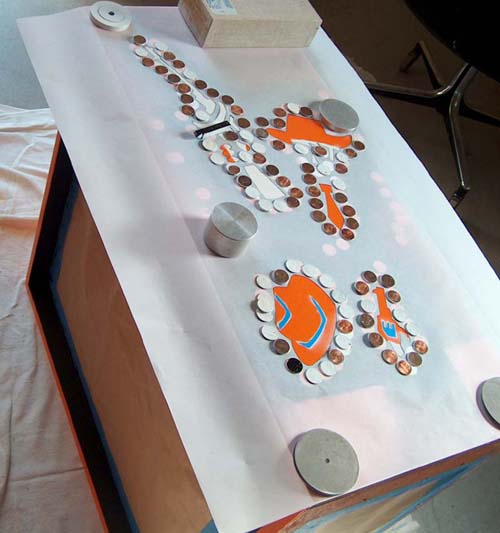
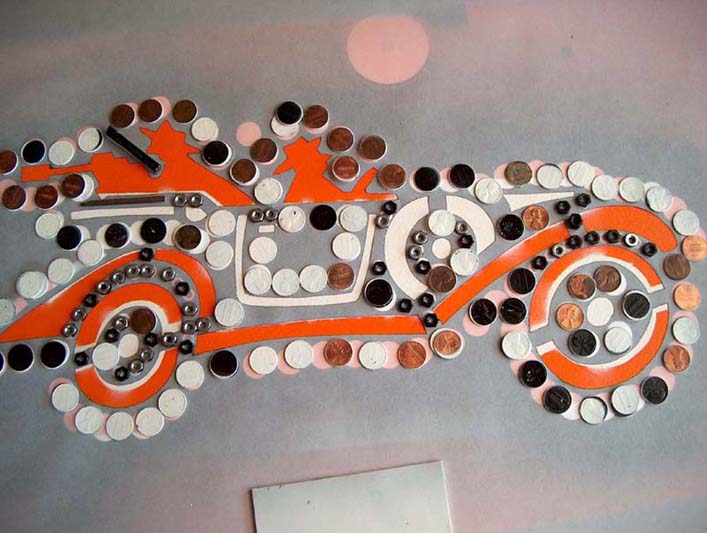 Here are a few pictures of a Kasco Untouchable game that I restored in 2005. Details on how this game is played can be found on my main webpage at the
Pictures of My Collection link. These two pictures show the cabinet
being repainted using custom stencils that I made by copying the existing cabinet artwork. After the stencils were traced, I completely stripped off the
old finish, repaired any cabinet damage and loose veneer, then repainted with color matched semi-gloss enamels.
Here are a few pictures of a Kasco Untouchable game that I restored in 2005. Details on how this game is played can be found on my main webpage at the
Pictures of My Collection link. These two pictures show the cabinet
being repainted using custom stencils that I made by copying the existing cabinet artwork. After the stencils were traced, I completely stripped off the
old finish, repaired any cabinet damage and loose veneer, then repainted with color matched semi-gloss enamels.
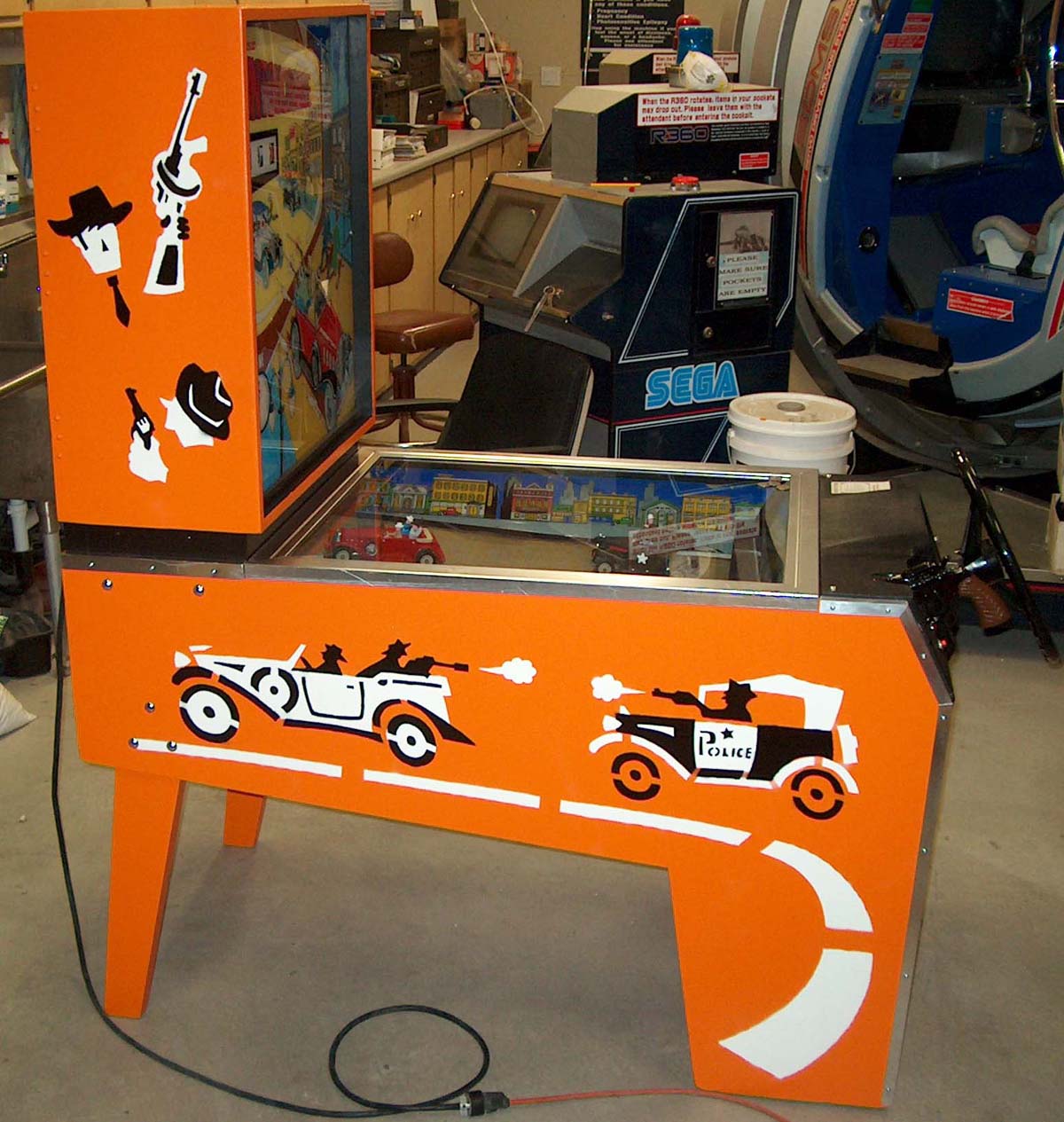
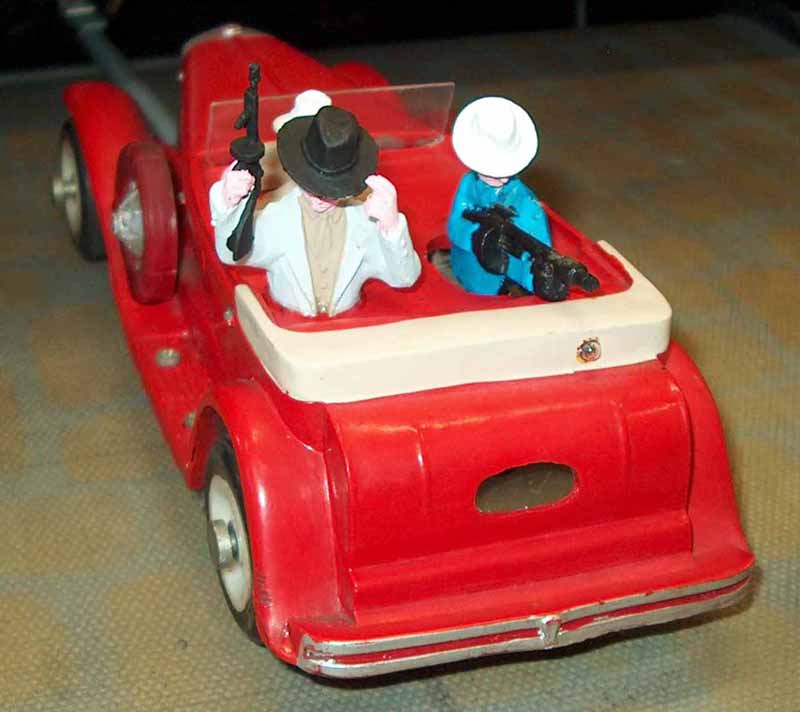 This is a close up of the robber's car. The gangster in the left rear seat is a replacement. I searched the internet and hobby stores to find a suitable
replacement for the missing mobster. The rest of the car is all original. Notice the "grain of wheat" light bulb in the white section of the car's rear
end (just under the right side gangster's machine gun). This lamp periodically flashes during game play to simulate the bad guys shooting at you. Also,
when you score a hit by shooting at these bad guys from your police car (using the gun mounted on the front of the cabinet), the gangster dressed
in blue will slump over as if he's been hit. You can watch this action by clicking on the the video link below. The sounds of screeching tires,
racing engines, breaking glass, crashing cars, machine guns and a woman's scream are all recorded on an 8-Track tape player.
This is a close up of the robber's car. The gangster in the left rear seat is a replacement. I searched the internet and hobby stores to find a suitable
replacement for the missing mobster. The rest of the car is all original. Notice the "grain of wheat" light bulb in the white section of the car's rear
end (just under the right side gangster's machine gun). This lamp periodically flashes during game play to simulate the bad guys shooting at you. Also,
when you score a hit by shooting at these bad guys from your police car (using the gun mounted on the front of the cabinet), the gangster dressed
in blue will slump over as if he's been hit. You can watch this action by clicking on the the video link below. The sounds of screeching tires,
racing engines, breaking glass, crashing cars, machine guns and a woman's scream are all recorded on an 8-Track tape player.
CLICK HERE for a short video of the Kasco Untouchable game in action. You will need a media player that can show ".AVI" files (Windows Media Player will work).
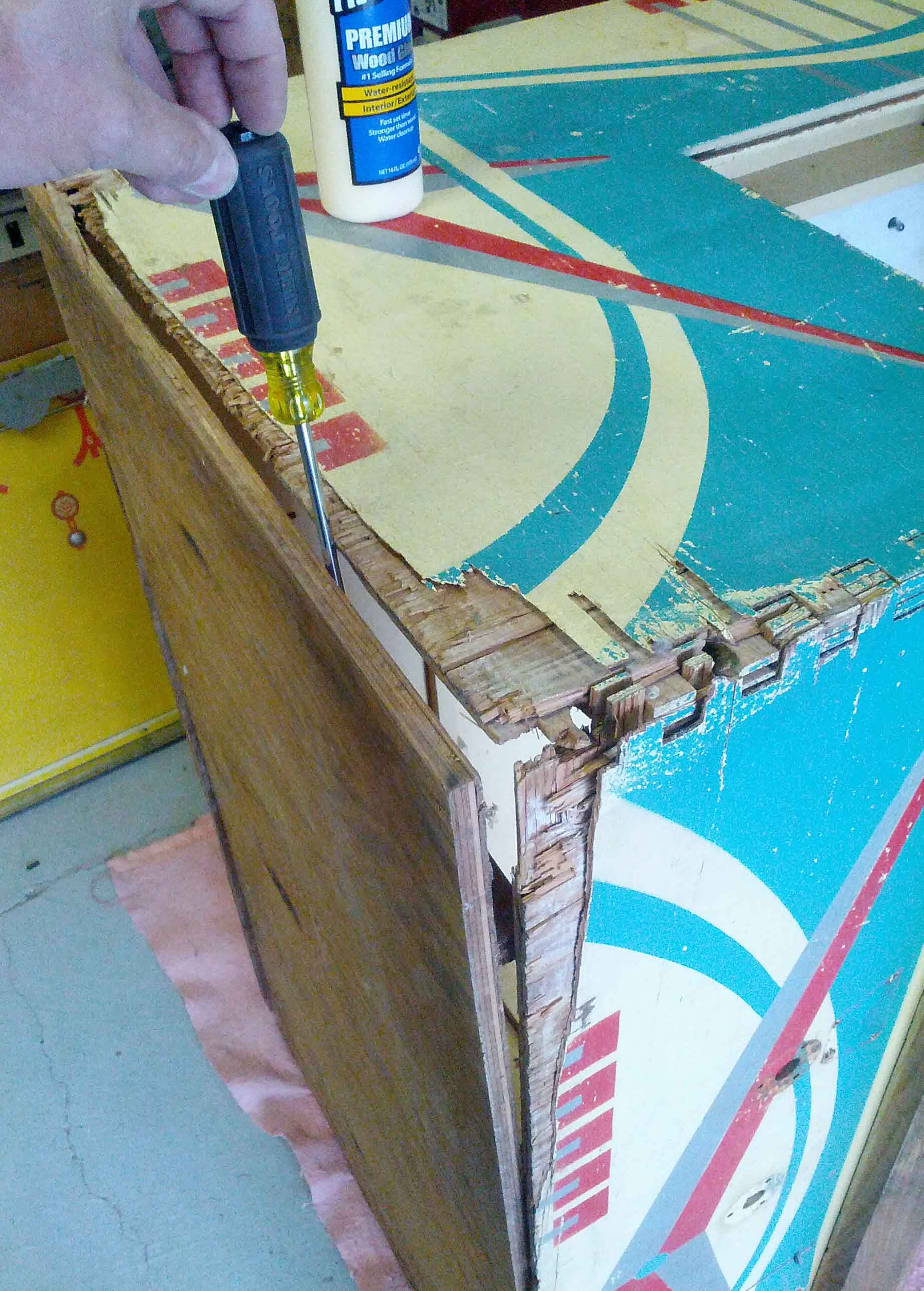
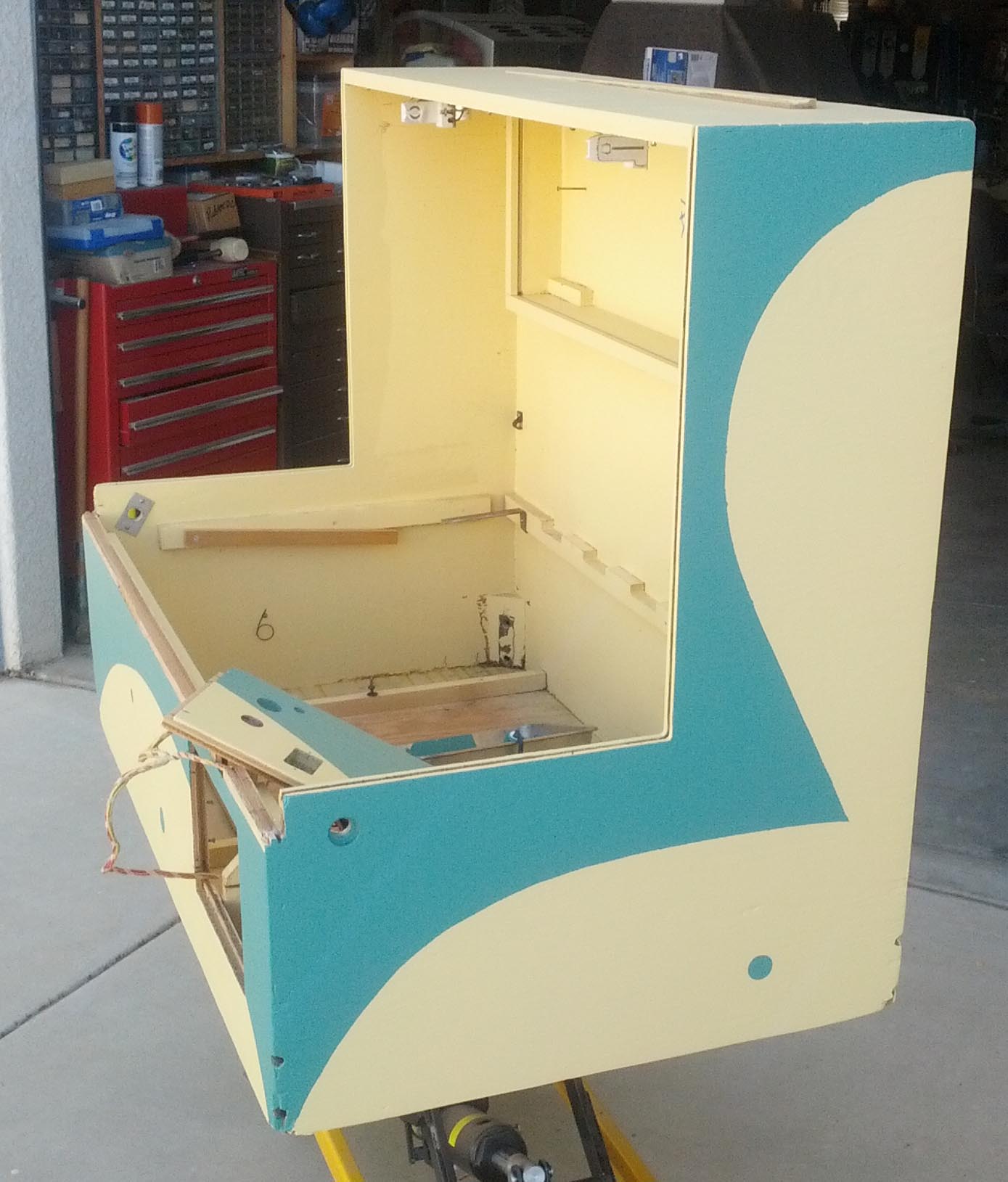
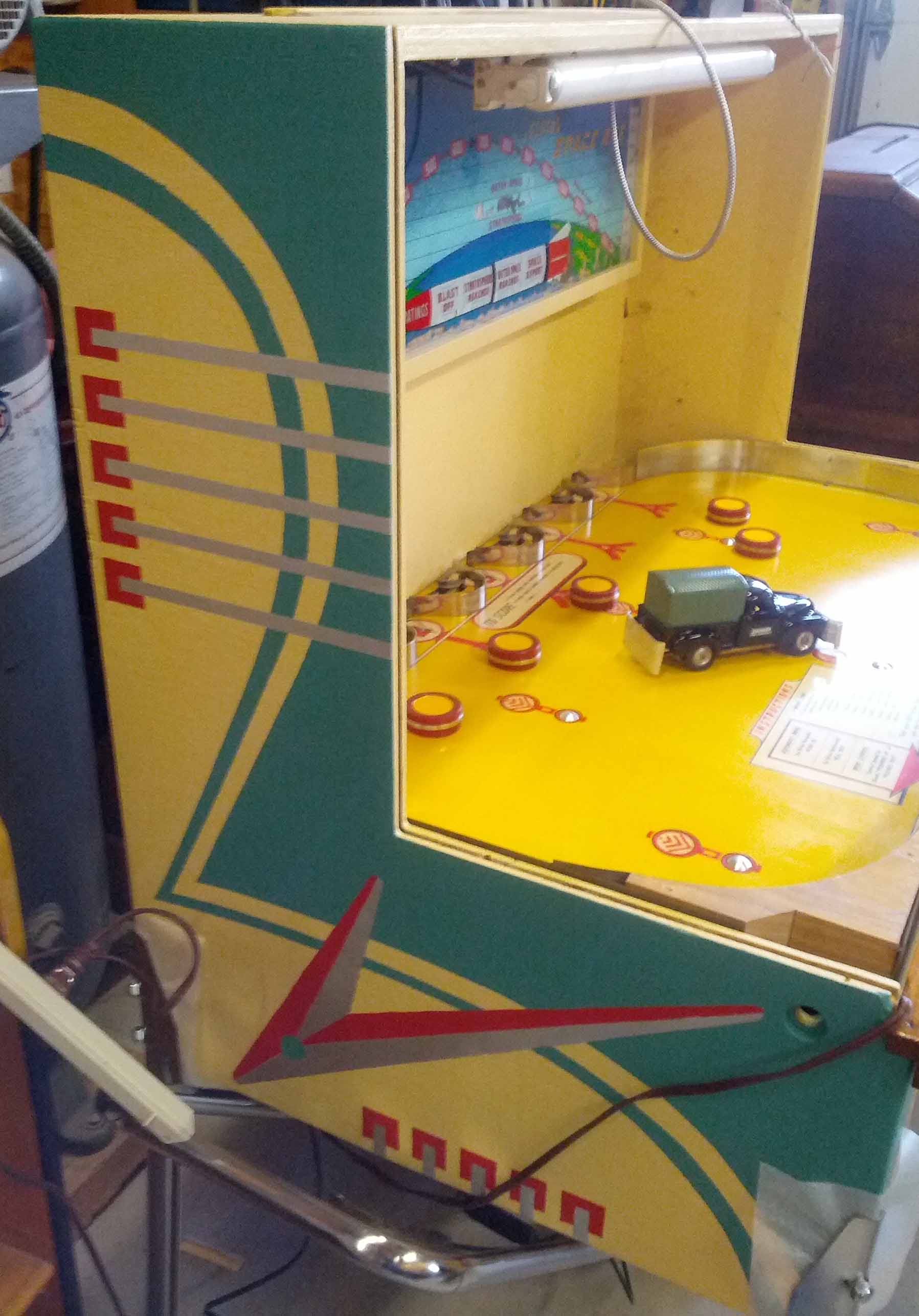 Here are a few pictures of a 1958 Genco Space Age cabinet that I restored. The first picture shows how badly the cabinet was falling apart.
The second picture was taken while the cabinet was being repainted using custom stencils that I made by copying the existing cabinet artwork.
As with all my restorations, I completely stripped off the old finish, repair and fill any damage, loose, or missing wood.
I then repaint with color matched semi-gloss enamels.
Here are a few pictures of a 1958 Genco Space Age cabinet that I restored. The first picture shows how badly the cabinet was falling apart.
The second picture was taken while the cabinet was being repainted using custom stencils that I made by copying the existing cabinet artwork.
As with all my restorations, I completely stripped off the old finish, repair and fill any damage, loose, or missing wood.
I then repaint with color matched semi-gloss enamels.
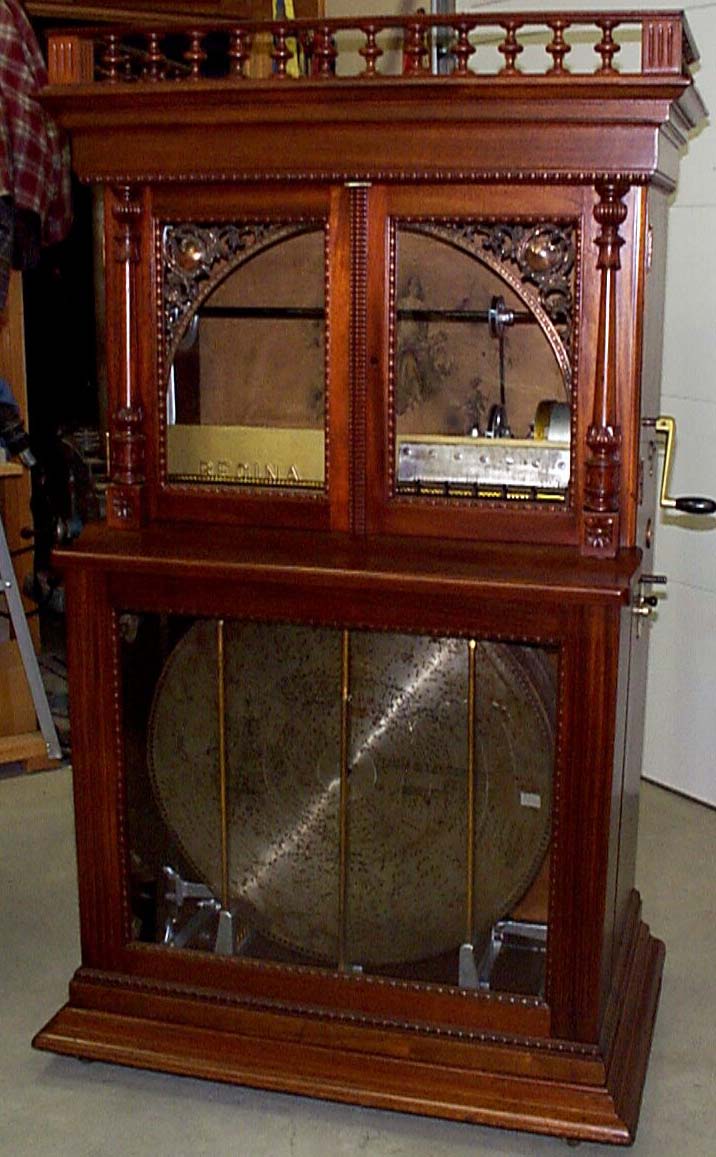 This is an antique disc music box made by the Regina Company in the late 1800's. It holds twelve 27" diameter metal discs and plays them one at a time.
The discs are stored in a rack located in the lower section of the cabinet. The rack moves forwards and backwards,
lifts each disc into playing position and clamps them onto the bedplate. Protrusions on the disc will rotate star wheels and pluck the dual combs
(which are the actual teeth that make the sound). The machine is run by two giant spring wound motors,
one to run the disc changing and loading mechanism, and one to spin the discs while they are playing.
This is an antique disc music box made by the Regina Company in the late 1800's. It holds twelve 27" diameter metal discs and plays them one at a time.
The discs are stored in a rack located in the lower section of the cabinet. The rack moves forwards and backwards,
lifts each disc into playing position and clamps them onto the bedplate. Protrusions on the disc will rotate star wheels and pluck the dual combs
(which are the actual teeth that make the sound). The machine is run by two giant spring wound motors,
one to run the disc changing and loading mechanism, and one to spin the discs while they are playing.
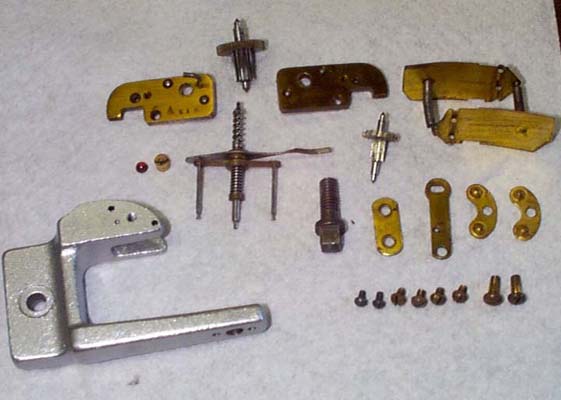
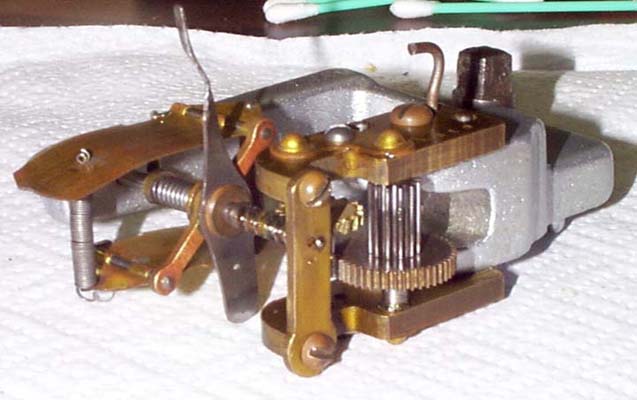 These two pictures show one small assembly inside the music box, which is called the "governor." Its function is to mechanically regulate the speed of the spring
motor. The Regina 27" Changer music box has two motors and two governors inside. One motor and governor set is used to
power the disk changing mechanism. The other set is used to play the disk. The first picture here, shows the individual
governor pieces after cleaning and inspection. The second picture shows the full
assembly after being put back together and mechanically adjusted.
These two pictures show one small assembly inside the music box, which is called the "governor." Its function is to mechanically regulate the speed of the spring
motor. The Regina 27" Changer music box has two motors and two governors inside. One motor and governor set is used to
power the disk changing mechanism. The other set is used to play the disk. The first picture here, shows the individual
governor pieces after cleaning and inspection. The second picture shows the full
assembly after being put back together and mechanically adjusted.
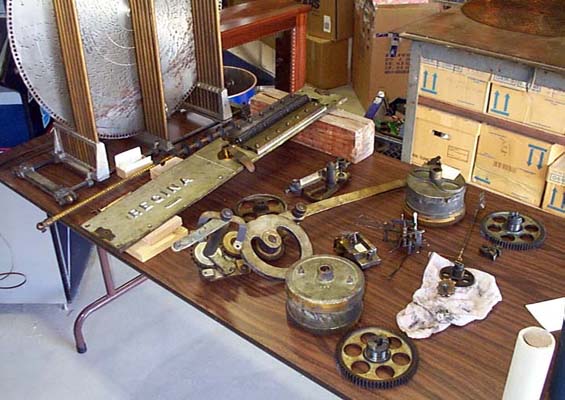
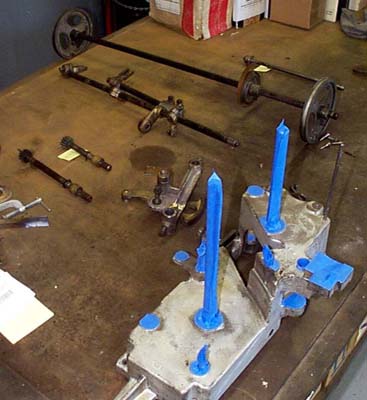 Various pieces of the changer mechanism before cleaning and during prep for new paint.
Various pieces of the changer mechanism before cleaning and during prep for new paint.
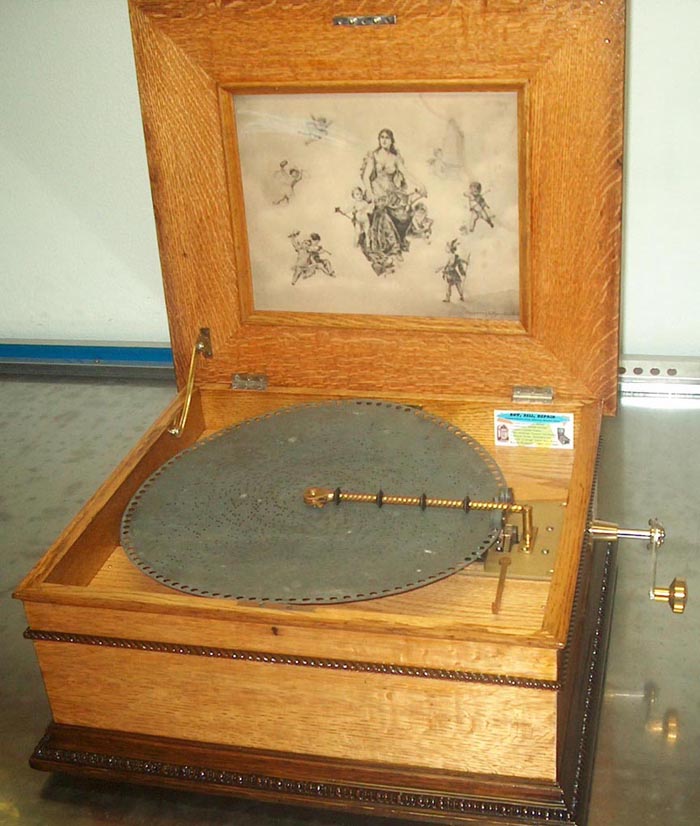 Another Regina music box that received a total restoration (cabinet refinish and mechanism rebuild). This machine plays 15-1/2" disks. The knob on the
winding handle was missing, I turned a new piece from solid brass on my lathe, polished it, then sealed it with three coats of high-gloss lacquer. The
owner of this machine asked me to restore it so that he could sell it at a local antique auction. It brought $3,750 (in November, 2005).
Another Regina music box that received a total restoration (cabinet refinish and mechanism rebuild). This machine plays 15-1/2" disks. The knob on the
winding handle was missing, I turned a new piece from solid brass on my lathe, polished it, then sealed it with three coats of high-gloss lacquer. The
owner of this machine asked me to restore it so that he could sell it at a local antique auction. It brought $3,750 (in November, 2005).
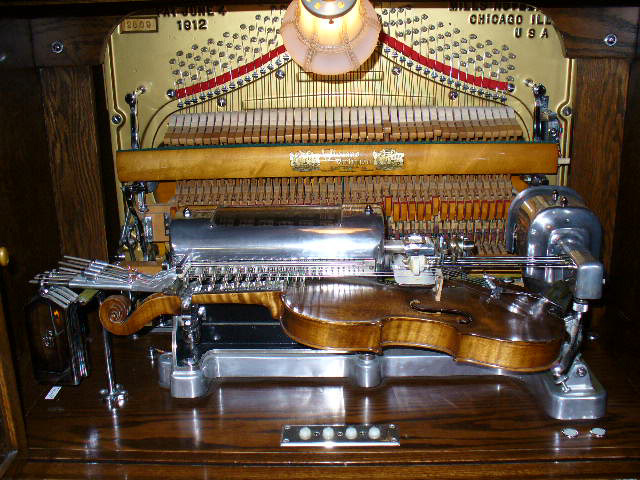 CLICK HERE to watch a short video of my Violano Virtuoso. This machine was made
in the early 1900s by the Mills Novelty Company. It plays an actual violin which is accompanied by a 44 note player piano.
CLICK HERE to watch a short video of my Violano Virtuoso. This machine was made
in the early 1900s by the Mills Novelty Company. It plays an actual violin which is accompanied by a 44 note player piano.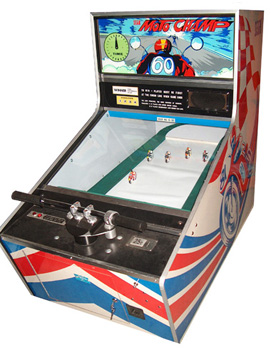
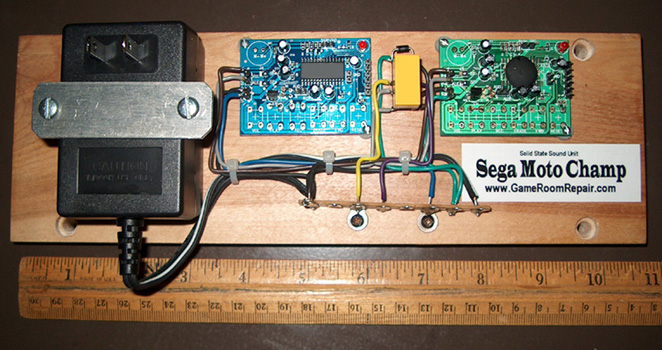 I restored a Sega Moto Champ for a customer in June, 2008. This game, like most '70s vintage games, uses an 8-track tape player
for its game sounds. Moto Champ uses two tracks on the tape. One track has engine sounds which simulate the roar of the motorcycles.
The second track has a trumpet fan fare song that is played when a free game is won. This game was missing its tape deck. Pictured
here, is a solid state replacement that I designed. This replacement contains all of the original game sounds which I recorded into special
integrated circuits after cleaning up the original audio tape to remove any clicks, pops, dropouts, and other unwanted imperfections.
It connects into the existing wiring harness in place of the original 8-track tape deck. No additional wiring or game modifications are
required. My replacement unit duplicates the operation of the original tape deck in every way. I can adapt this sound unit for any game
that needs a replacement. If your tape deck is old and tired, or completely MIA (missing-in-action), contact me for pricing and
additional information. My sound units cost between $500 and $1200 depending on the complexity of sound in a game (IE: the number of individual
tracks used on the original 8-track tape and the sequencing of when those tracks are played).
I restored a Sega Moto Champ for a customer in June, 2008. This game, like most '70s vintage games, uses an 8-track tape player
for its game sounds. Moto Champ uses two tracks on the tape. One track has engine sounds which simulate the roar of the motorcycles.
The second track has a trumpet fan fare song that is played when a free game is won. This game was missing its tape deck. Pictured
here, is a solid state replacement that I designed. This replacement contains all of the original game sounds which I recorded into special
integrated circuits after cleaning up the original audio tape to remove any clicks, pops, dropouts, and other unwanted imperfections.
It connects into the existing wiring harness in place of the original 8-track tape deck. No additional wiring or game modifications are
required. My replacement unit duplicates the operation of the original tape deck in every way. I can adapt this sound unit for any game
that needs a replacement. If your tape deck is old and tired, or completely MIA (missing-in-action), contact me for pricing and
additional information. My sound units cost between $500 and $1200 depending on the complexity of sound in a game (IE: the number of individual
tracks used on the original 8-track tape and the sequencing of when those tracks are played).
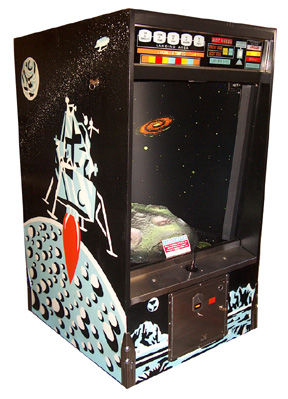
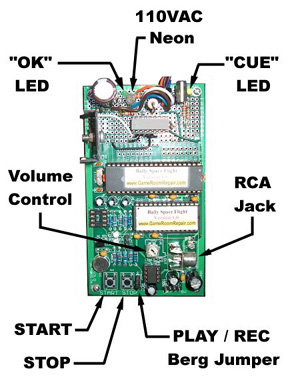 The 1969 Bally Space Flight game uses a very special 8-track player. The tape contains a momentary burst of 1kHz tone
that is placed on the tape every 18.5 seconds. This tone burst is not heard through the speaker. Its purpose is to synchronize the entire game.
An analog PCB inside the tape deck detects the 1kHz tone and sends a signal to the game. This signal causes the lunar module to start its decent
towards the moon's surface. Without this tape and the tone detector board, the game won't run! Of the four Space Flight machines that have
passed through my shop, only one had a good working tape deck. Pictured here, is a solid state replacement unit (model #S3-01) that I designed.
The unit is run by a microcontroller that replicates all of the original 8-track functions. It plugs into the existing connector
in place of the original 8-track tape deck. No additional wiring or game modifications are required. There are 42 different messages contained
in the solid state audio chip, for a total of eight minutes worth of sound. Each message is the voice of the launch Commander in Houston, TX.
I cleaned up the original audio file to remove all unwanted imperfections.
The cost of my Solid State Sound (or "S3") Replacement Unit is $2,675.00 plus shipping and insurance.
Each one is hand assembled and programmed, taking two full days to complete. It is then fully tested and comes with a one year warranty.
I only have two of these left in stock, and I will not be making any more.
The 1969 Bally Space Flight game uses a very special 8-track player. The tape contains a momentary burst of 1kHz tone
that is placed on the tape every 18.5 seconds. This tone burst is not heard through the speaker. Its purpose is to synchronize the entire game.
An analog PCB inside the tape deck detects the 1kHz tone and sends a signal to the game. This signal causes the lunar module to start its decent
towards the moon's surface. Without this tape and the tone detector board, the game won't run! Of the four Space Flight machines that have
passed through my shop, only one had a good working tape deck. Pictured here, is a solid state replacement unit (model #S3-01) that I designed.
The unit is run by a microcontroller that replicates all of the original 8-track functions. It plugs into the existing connector
in place of the original 8-track tape deck. No additional wiring or game modifications are required. There are 42 different messages contained
in the solid state audio chip, for a total of eight minutes worth of sound. Each message is the voice of the launch Commander in Houston, TX.
I cleaned up the original audio file to remove all unwanted imperfections.
The cost of my Solid State Sound (or "S3") Replacement Unit is $2,675.00 plus shipping and insurance.
Each one is hand assembled and programmed, taking two full days to complete. It is then fully tested and comes with a one year warranty.
I only have two of these left in stock, and I will not be making any more.
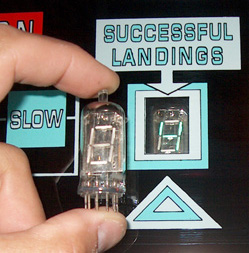
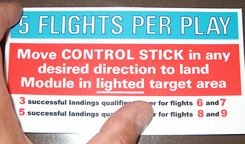 SPACE FLIGHT PARTS FOR SALE:
SPACE FLIGHT PARTS FOR SALE:
Reproduction upper glass. Looks exactly like the original except made from Lexan plastic, $689.00. Made to the correct full size of 6"x30", but you must reuse the existing metal edge-trim pieces from your old glass. Shipping and insurance is extra on all items.
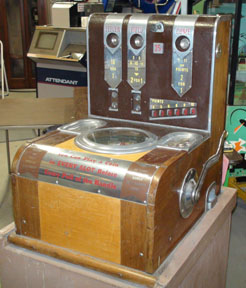
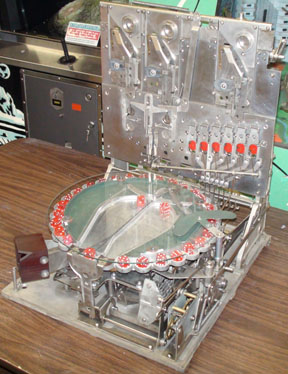 This is a payout gambling machine made in the 1930s that plays the dice game of craps. It's simply called "Mills Dice."
You can place up to three seperate bets at once, each costing a quarter. When you place your bets and crank the handle, a pair of dice
are heard to shake and are then thrown into the large glass dome viewing window. The three individual bets that you can make are:
"Eleven" which pays 16 to 1, the "Field" which pays 2 to 1, and the "Come" which pays 2 to 1.
The Eleven and Field bets are good for a single pull of the handle. New bets can be placed in these coin slots every handle pull if desired.
When betting on the Come, if you roll a 7 or 11, you instantly win two coins.
If instead you roll a 4, 5, 6, 8, 9, or 10, this is called your "point." The coin you just bet will appear in the appropriate point pocket window
for all to see. You then keep playing the game (for free) by cranking the handle repeatedly,
which re-throws the dice. You continue to play until either your point is made (you win two coins) or you roll a 7 (loser) which ends the game.
In either case, once you win or lose, your coin drops out of the point pocket and the game is over.
This is a payout gambling machine made in the 1930s that plays the dice game of craps. It's simply called "Mills Dice."
You can place up to three seperate bets at once, each costing a quarter. When you place your bets and crank the handle, a pair of dice
are heard to shake and are then thrown into the large glass dome viewing window. The three individual bets that you can make are:
"Eleven" which pays 16 to 1, the "Field" which pays 2 to 1, and the "Come" which pays 2 to 1.
The Eleven and Field bets are good for a single pull of the handle. New bets can be placed in these coin slots every handle pull if desired.
When betting on the Come, if you roll a 7 or 11, you instantly win two coins.
If instead you roll a 4, 5, 6, 8, 9, or 10, this is called your "point." The coin you just bet will appear in the appropriate point pocket window
for all to see. You then keep playing the game (for free) by cranking the handle repeatedly,
which re-throws the dice. You continue to play until either your point is made (you win two coins) or you roll a 7 (loser) which ends the game.
In either case, once you win or lose, your coin drops out of the point pocket and the game is over.
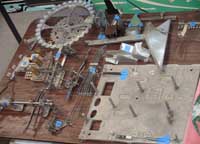
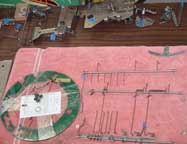
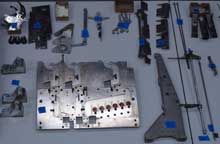
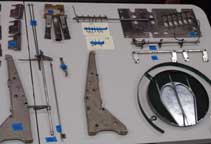 Do you like to put puzzles together?
Do you like to put puzzles together?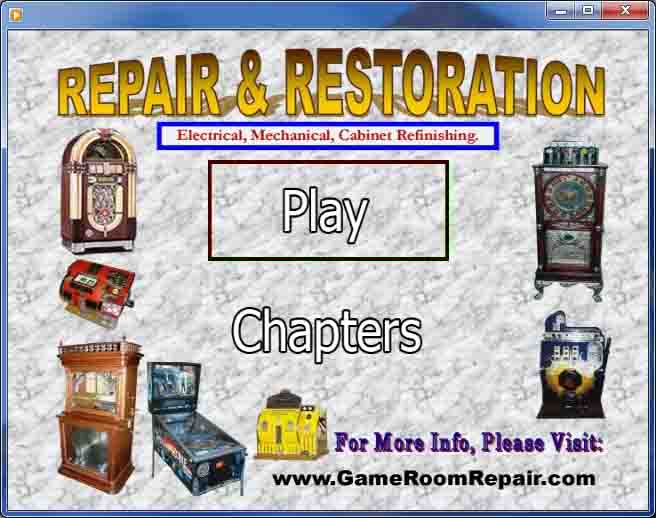 I've created an instructional DVD video in high-definition, that was taken during the restoration of this game. The video runs approximately 1 hour & 38 minutes,
and contains the following thirteen chapters: 1) Introduction. 2) How Does it Read the Dice? 3) Place Your Bets. 4) Removing Mech From Cabinet.
5) Mech Assembly Process. 6) Clock and Tilt Mechs. 7) Dice Shaker/Sound Generator. 8) Interaction Between Mech and Cabinet. 9) Payout Sequence.
10) Repairs. 11) Mech Adjustments. 12) Cabinet refinishing. 13) Conclusion.
I've created an instructional DVD video in high-definition, that was taken during the restoration of this game. The video runs approximately 1 hour & 38 minutes,
and contains the following thirteen chapters: 1) Introduction. 2) How Does it Read the Dice? 3) Place Your Bets. 4) Removing Mech From Cabinet.
5) Mech Assembly Process. 6) Clock and Tilt Mechs. 7) Dice Shaker/Sound Generator. 8) Interaction Between Mech and Cabinet. 9) Payout Sequence.
10) Repairs. 11) Mech Adjustments. 12) Cabinet refinishing. 13) Conclusion. 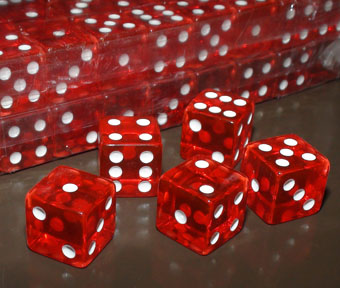 Do you need new dice for your Mills Dice machine?
Do you need new dice for your Mills Dice machine?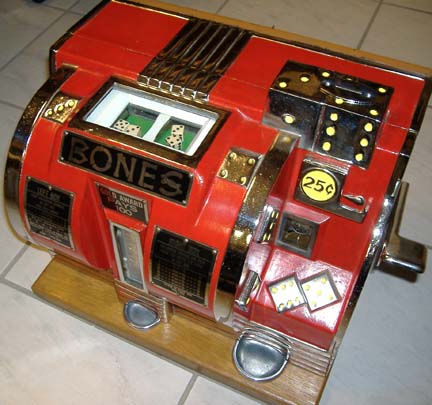
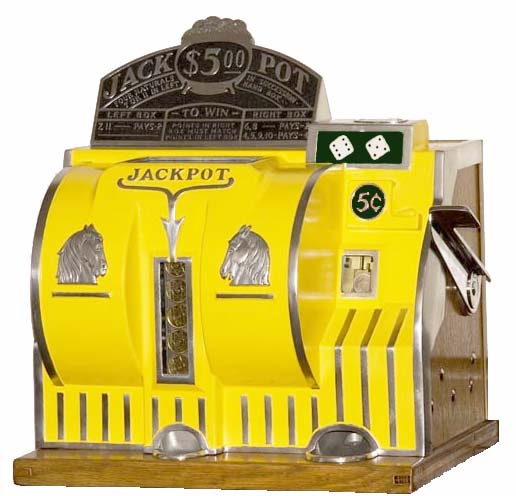 These are more (all mechanical) payout dice machines, also made in the 1930s. The red machine is a Buckley Bones.
The yellow one is a Bally Reliance. They both use the same internal mechanism. When you insert a coin and crank the handle, a pair of dice
are heard to shake and are then thrown into the left-side viewing window. This is your "come-out" roll. If you roll a 7 or 11, you instantly win two coins.
If you roll a 2, 3, or 12, then you have just "Crapped-Out" and the game ends (handle cannot be cranked until another coin is played).
If you roll a 4, 5, 6, 8, 9, or 10, this is your "point" and you get to continue playing the game (for free) by cranking the handle repeatedly,
which then throws out a second pair of dice in the right-side viewing window. You continue to crank the handle and roll the right hand dice until either your
point is made (you win) or you roll a 7 (a loser) which ends the game. If you win on the point roll, a 6 or 8 will pay two coins while a 4, 5, 9, or 10
will pay eight coins. The game also has a jackpot that is equivalent to 100 coins. The jackpot, called the "Gold Award," can be seen through a window
on the front of the machine. The award is a gold token that is good for 100 coins when presented to the owner of the machine. Each coin has a unique
serial number stamped on its back so the proprietor could keep track of the winners and also verify that the gold coin came from his machine.
I have posted a five part video series on YouTube that walks you through the complete operation of the Buckley Bones and shows the game in action.
Details include the machine completely torn apart and then reassembled.
These are more (all mechanical) payout dice machines, also made in the 1930s. The red machine is a Buckley Bones.
The yellow one is a Bally Reliance. They both use the same internal mechanism. When you insert a coin and crank the handle, a pair of dice
are heard to shake and are then thrown into the left-side viewing window. This is your "come-out" roll. If you roll a 7 or 11, you instantly win two coins.
If you roll a 2, 3, or 12, then you have just "Crapped-Out" and the game ends (handle cannot be cranked until another coin is played).
If you roll a 4, 5, 6, 8, 9, or 10, this is your "point" and you get to continue playing the game (for free) by cranking the handle repeatedly,
which then throws out a second pair of dice in the right-side viewing window. You continue to crank the handle and roll the right hand dice until either your
point is made (you win) or you roll a 7 (a loser) which ends the game. If you win on the point roll, a 6 or 8 will pay two coins while a 4, 5, 9, or 10
will pay eight coins. The game also has a jackpot that is equivalent to 100 coins. The jackpot, called the "Gold Award," can be seen through a window
on the front of the machine. The award is a gold token that is good for 100 coins when presented to the owner of the machine. Each coin has a unique
serial number stamped on its back so the proprietor could keep track of the winners and also verify that the gold coin came from his machine.
I have posted a five part video series on YouTube that walks you through the complete operation of the Buckley Bones and shows the game in action.
Details include the machine completely torn apart and then reassembled.
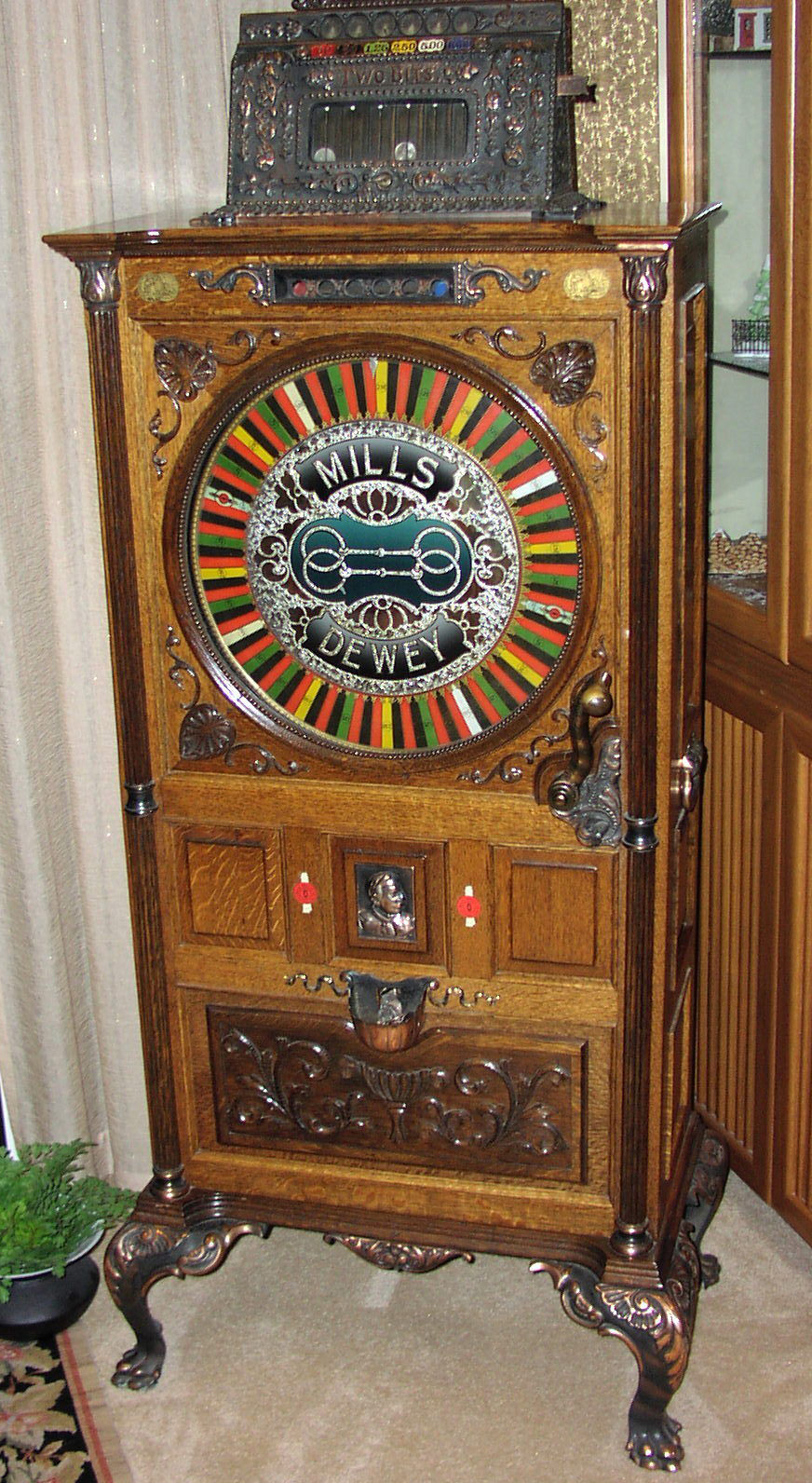 An upright single-wheel slot machine with a patent date of 1899, made by the Mills Novelty Company in Chicago, IL. This is the "Two Bits Dewey" model. Two Bits means that is takes a quarter to play (as eight bits = $1.00). Mills also included a pair or horse bridal bits (two bits) on the center glass to further tie in the theme of 25 cent play. Most machines at the start of the 20th century were a penny or nickle play. The Dewey model was named after Admiral Dewey who had just returned as a naval war hero after winning a key battle in the Spanish-American War. The Dewey came in a number of variations including a model that had a visible jackpot, a model that played a music cylinder in its base with every handle pull, and a variety of cabinet metal castings, center glass designs, and color wheel designs.
An upright single-wheel slot machine with a patent date of 1899, made by the Mills Novelty Company in Chicago, IL. This is the "Two Bits Dewey" model. Two Bits means that is takes a quarter to play (as eight bits = $1.00). Mills also included a pair or horse bridal bits (two bits) on the center glass to further tie in the theme of 25 cent play. Most machines at the start of the 20th century were a penny or nickle play. The Dewey model was named after Admiral Dewey who had just returned as a naval war hero after winning a key battle in the Spanish-American War. The Dewey came in a number of variations including a model that had a visible jackpot, a model that played a music cylinder in its base with every handle pull, and a variety of cabinet metal castings, center glass designs, and color wheel designs.
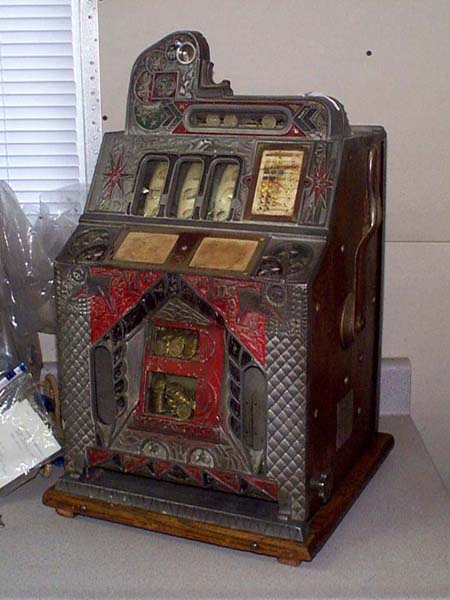
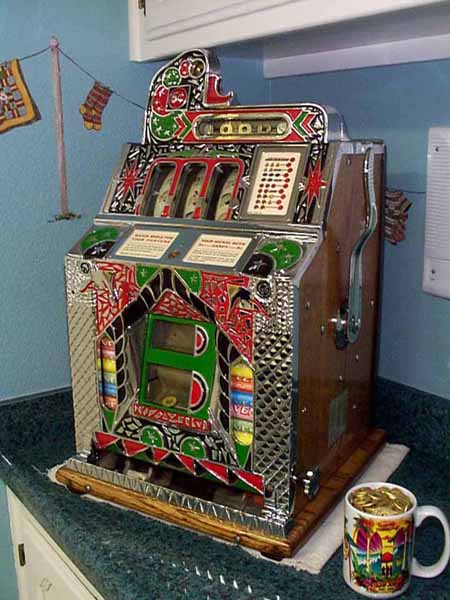 These are before and after pictures of a slot machine from the 1930s, made by the Mills Novelty Co. It is called an "FOK Vendor" (which stands for Front O.K. Vendor).
This machine vends a roll of mints for each nickel played, it was a way to get around the gambling laws of some states because you
"got something for your money" so it wasn't a "gambling device" (that's what the manufacturer claimed, most law enforcement
officials didn't agree...). This slot machine also tells your fortune by lining up words of a complete sentence across the three reels.
Each spin of the reels lined up different parts of the sentence to form your complete fortune.
These are before and after pictures of a slot machine from the 1930s, made by the Mills Novelty Co. It is called an "FOK Vendor" (which stands for Front O.K. Vendor).
This machine vends a roll of mints for each nickel played, it was a way to get around the gambling laws of some states because you
"got something for your money" so it wasn't a "gambling device" (that's what the manufacturer claimed, most law enforcement
officials didn't agree...). This slot machine also tells your fortune by lining up words of a complete sentence across the three reels.
Each spin of the reels lined up different parts of the sentence to form your complete fortune.
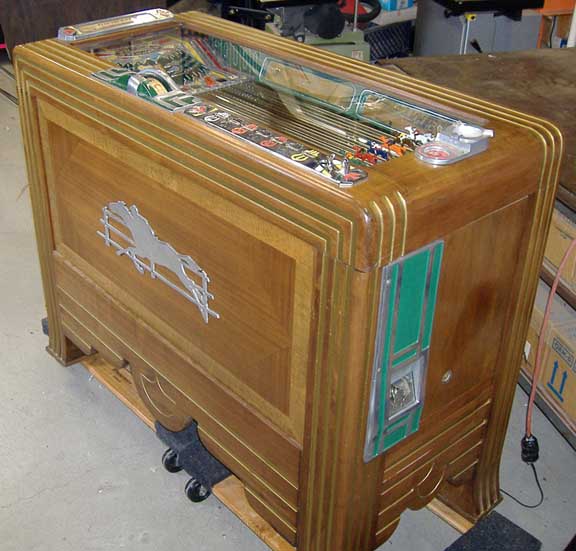 This is a payout gambling machine from the 1930s. It's called Paces Races. I restored this machine for a customer in Beverly Hills, CA.
The game uses an electric motor to pump a set of pneumatic bellows, which creates a constant vacuum that runs the entire game.
You can watch three videos of the game in action by clicking on the links below. The position of each horse as they move
alone the track, is determined by holes punched in a piano roll. The roll is pulled over a tracker bar in the same fashion as player pianos
of the same vintage. As the holes in the paper pass over the tracker bar, air is sucked into various valves that open and cause larger
bellows to collapse. These larger bellows are linked to the horses and cause them to jump or gallop towards the finish line.
Many other things are happening inside this game, and it's all driven by vacuum! The game is a payout slot machine with jackpot feature.
You win the jackpot if your horse comes in first, has 30-to-1 payout odds (set at the start of each game, after the horses
take off running), and if the "lucky fortune wheel" (which also spins after game start) lands on a horseshoe symbol with the word "Winner"
written on it.
This is a payout gambling machine from the 1930s. It's called Paces Races. I restored this machine for a customer in Beverly Hills, CA.
The game uses an electric motor to pump a set of pneumatic bellows, which creates a constant vacuum that runs the entire game.
You can watch three videos of the game in action by clicking on the links below. The position of each horse as they move
alone the track, is determined by holes punched in a piano roll. The roll is pulled over a tracker bar in the same fashion as player pianos
of the same vintage. As the holes in the paper pass over the tracker bar, air is sucked into various valves that open and cause larger
bellows to collapse. These larger bellows are linked to the horses and cause them to jump or gallop towards the finish line.
Many other things are happening inside this game, and it's all driven by vacuum! The game is a payout slot machine with jackpot feature.
You win the jackpot if your horse comes in first, has 30-to-1 payout odds (set at the start of each game, after the horses
take off running), and if the "lucky fortune wheel" (which also spins after game start) lands on a horseshoe symbol with the word "Winner"
written on it.
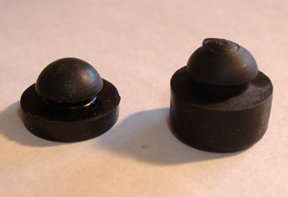
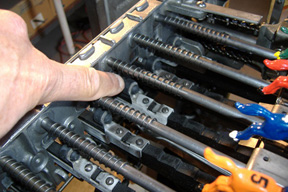
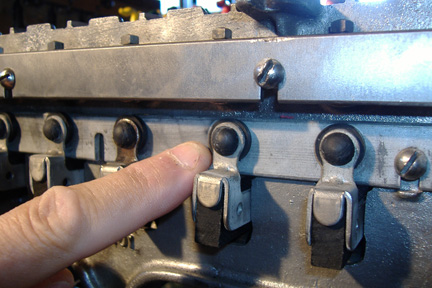 Paces Races uses a set or fourteen rubber bumpers which act as cushions or shock absorbers for the wooden racks that advance the horses.
The thicker bumpers go on the inside and the thinner bumpers go on the outside as seen here. I sell brand new bumpers, shown in the
first picture, for $32.95 per full set of 14pcs, or $22.95 for two or more sets.
I have posted three videos on YouTube that walk you through the operation of Paces Races and show the game in action.
Paces Races uses a set or fourteen rubber bumpers which act as cushions or shock absorbers for the wooden racks that advance the horses.
The thicker bumpers go on the inside and the thinner bumpers go on the outside as seen here. I sell brand new bumpers, shown in the
first picture, for $32.95 per full set of 14pcs, or $22.95 for two or more sets.
I have posted three videos on YouTube that walk you through the operation of Paces Races and show the game in action. 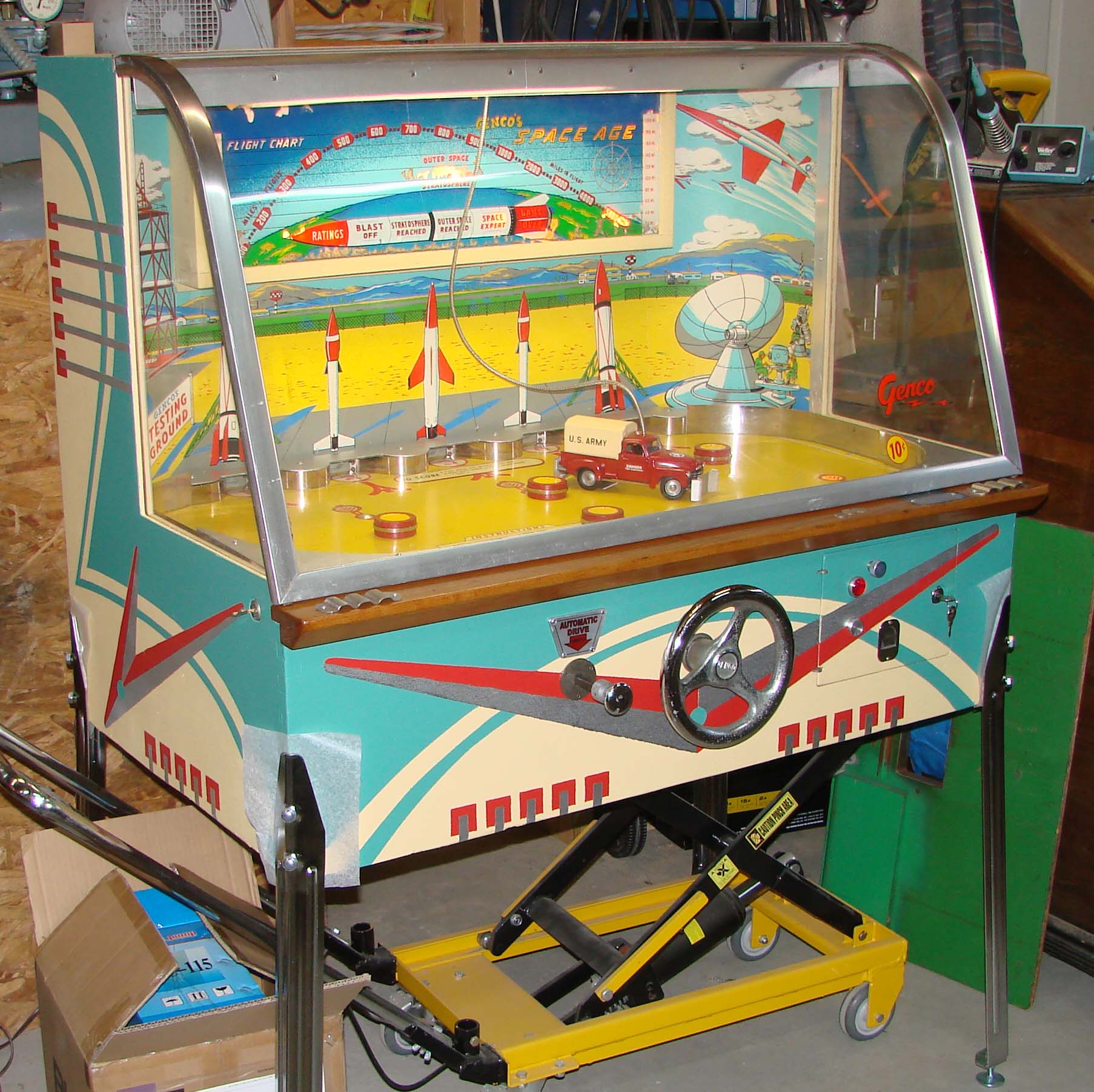 Genco's Space Age
Genco's Space Age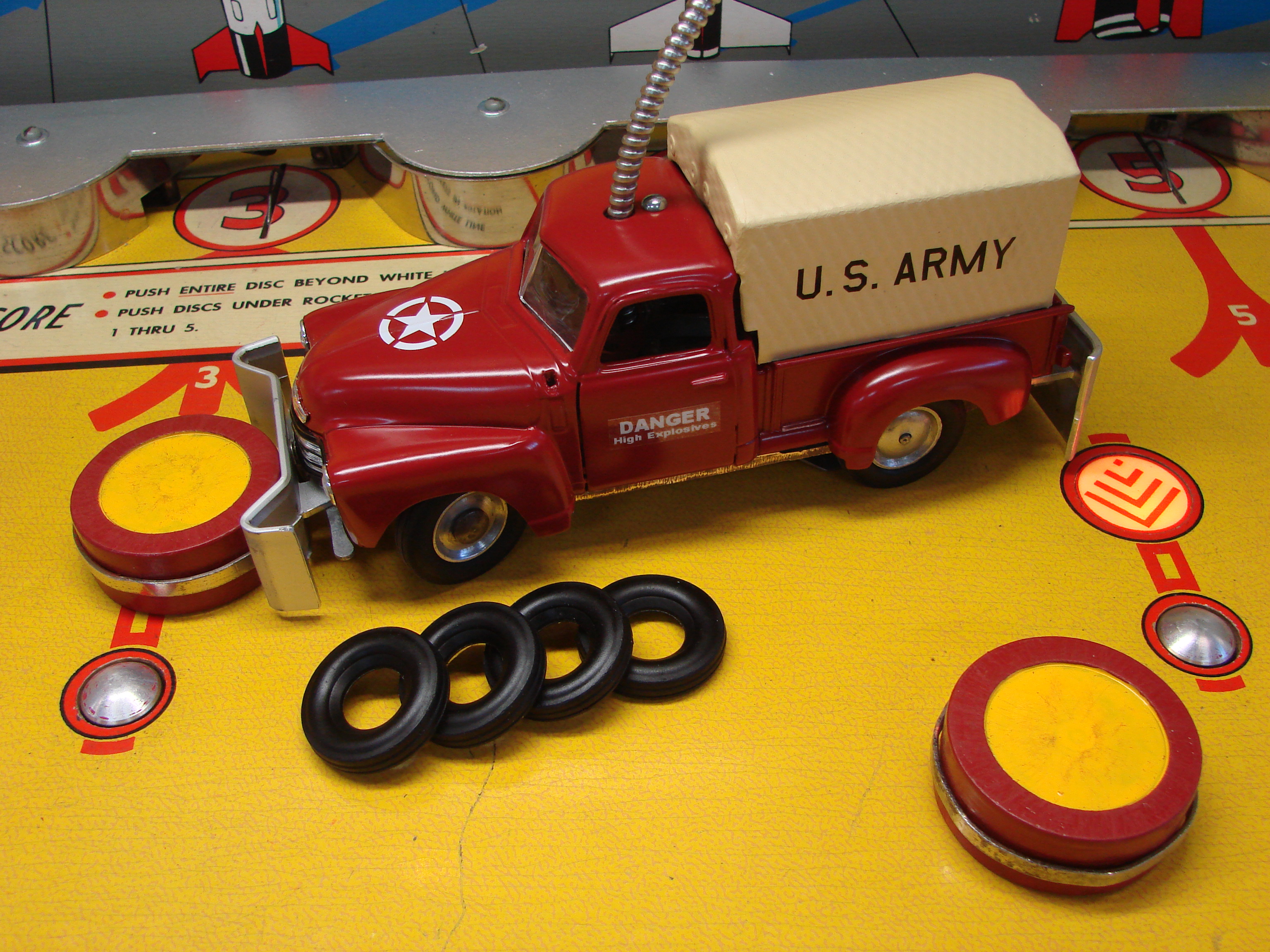 I make Brand New Reproduction Tires for Space Age and Motorama.
I make Brand New Reproduction Tires for Space Age and Motorama. 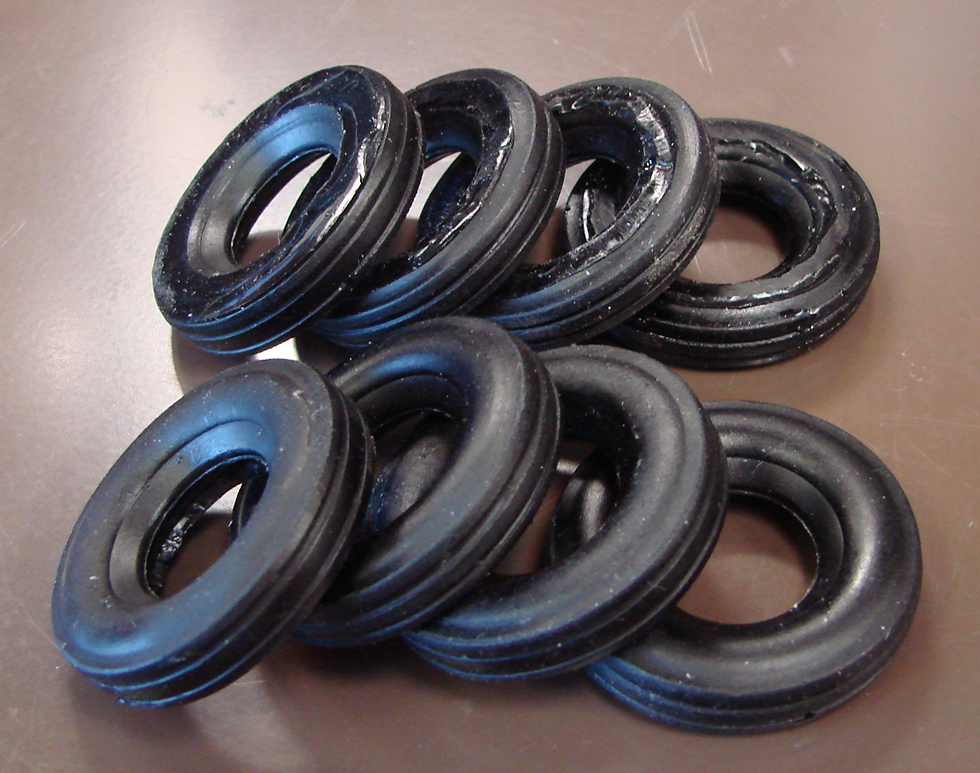 Shown here are two sets of tires. The upper 4 tires have their "rough side" facing up so you can see that they have some en-even areas. But these sides are facing the inside (towards the car body), so the un-even surfaces are hidden. The lower 4 tires in the foreground are what you see when mounted on the vehicle. They are just like the originals.
Shown here are two sets of tires. The upper 4 tires have their "rough side" facing up so you can see that they have some en-even areas. But these sides are facing the inside (towards the car body), so the un-even surfaces are hidden. The lower 4 tires in the foreground are what you see when mounted on the vehicle. They are just like the originals.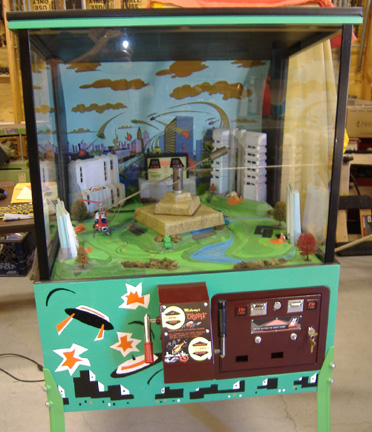 Midway's Chopper
Midway's Chopper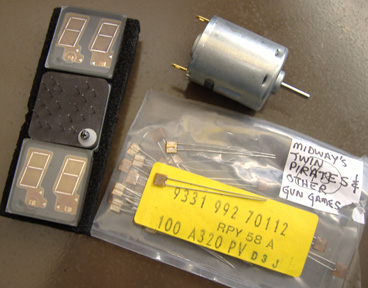
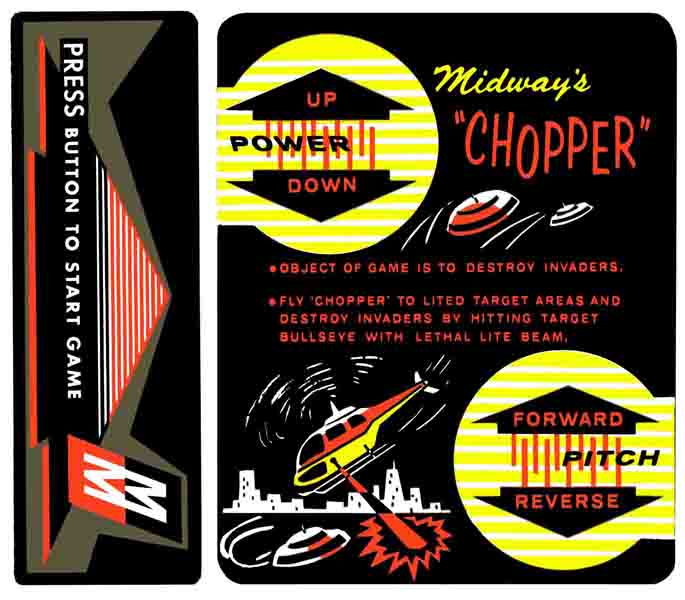 I have these parts available for Midway's Chopper.
I have these parts available for Midway's Chopper. 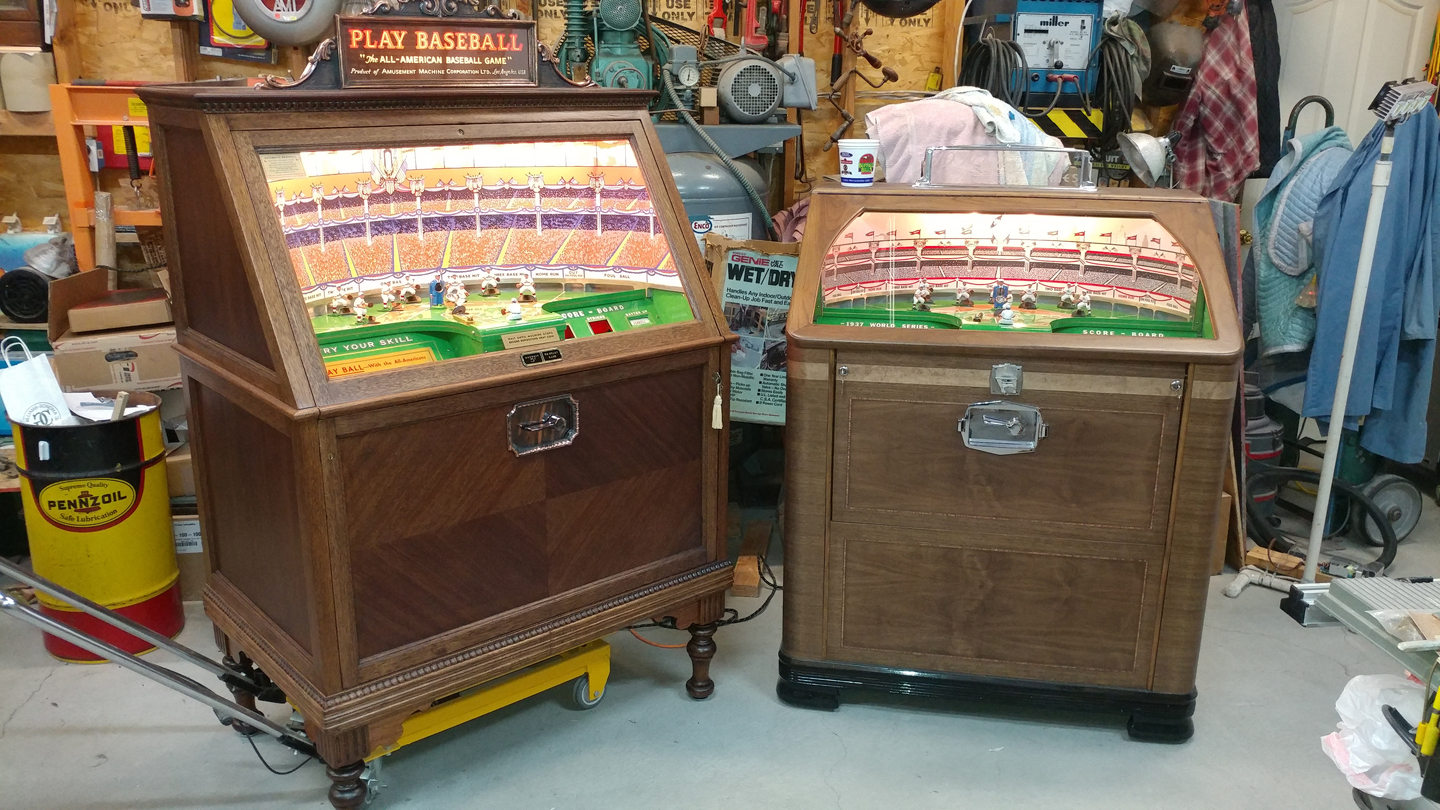 1937 World Series - by Rockola.
1937 World Series - by Rockola.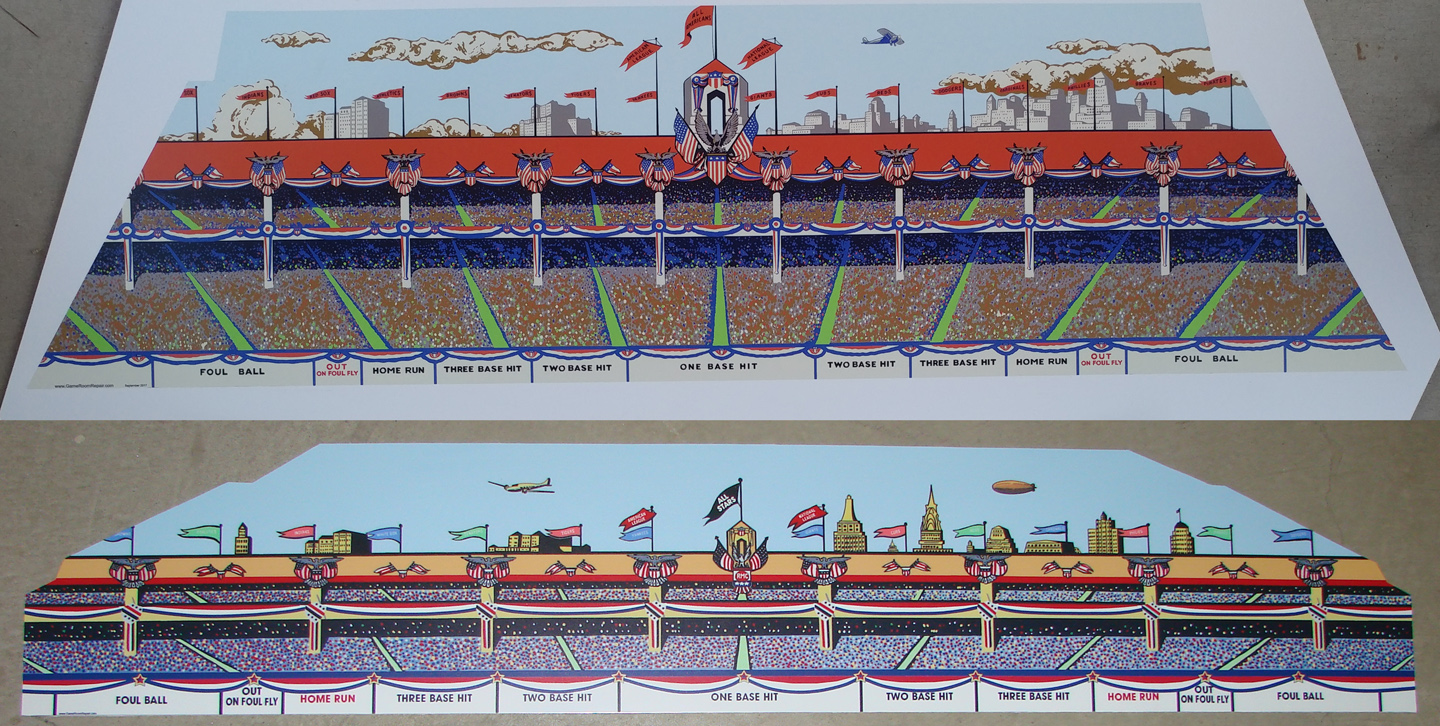 These are my reproduction backdrops (grandstands scenery) for both All American Baseball and Rockola World Series.
My backdops are printed on 0.060" polystyrene and then laminated with a semi-gloss film so it is super durable, washable, and won't crease or crack like the original cardboard.
They can be modified if you have custom requests. Colors can be changed and images can be added or re-arranged. Contact me for pricing and availability.
These are my reproduction backdrops (grandstands scenery) for both All American Baseball and Rockola World Series.
My backdops are printed on 0.060" polystyrene and then laminated with a semi-gloss film so it is super durable, washable, and won't crease or crack like the original cardboard.
They can be modified if you have custom requests. Colors can be changed and images can be added or re-arranged. Contact me for pricing and availability.
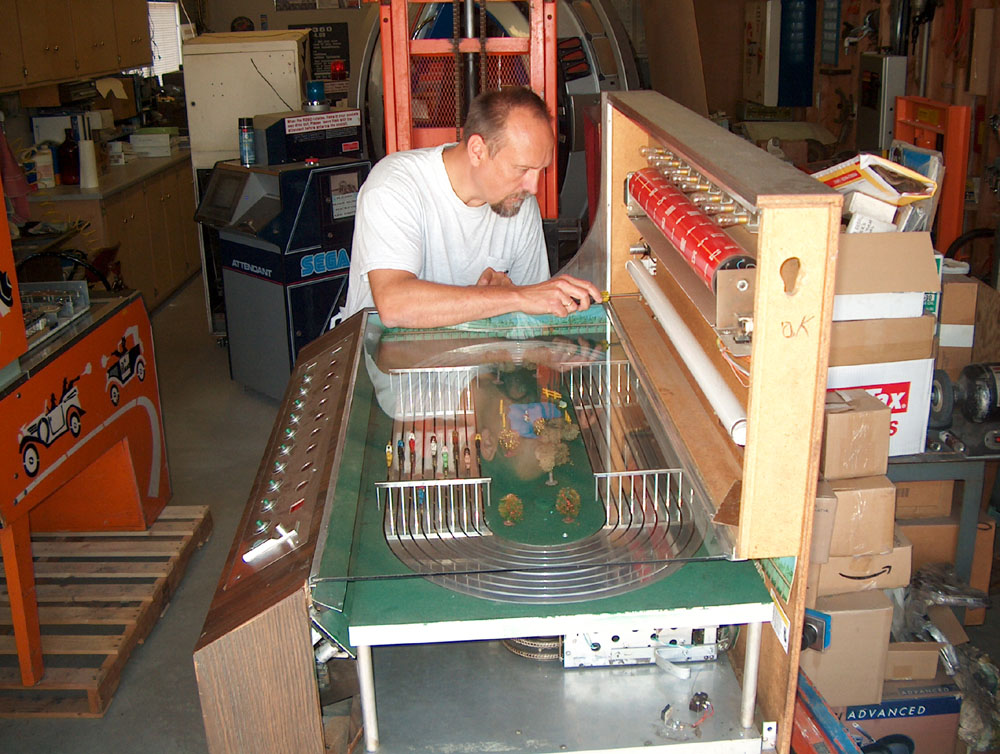 Quarter Horse Derby
Quarter Horse Derby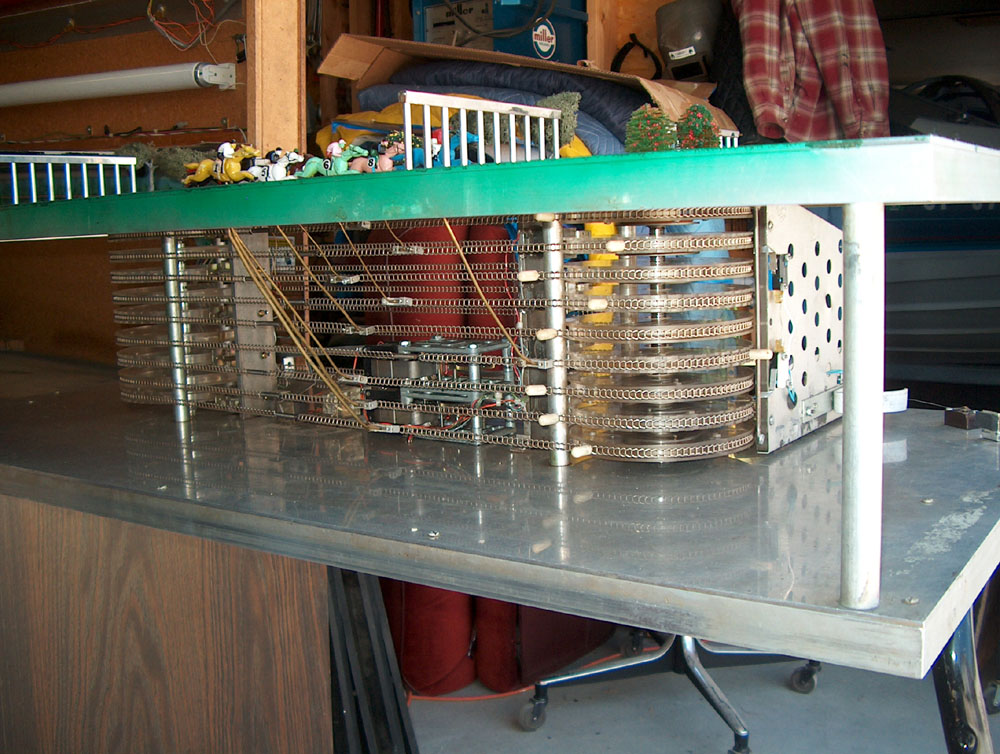 This picture shows the mechanism below the race track that makes the horses move. Each horse is connected to a separate chain. All chains are
driven by large plastic wheels. The wheels have notches around their outside diameters. Relay armatures will momentarilly fall into these notches
during a race and cause the horses to abruptly stop, then start moving again. This is what causes them to gallop while they race around the track.
This picture shows the mechanism below the race track that makes the horses move. Each horse is connected to a separate chain. All chains are
driven by large plastic wheels. The wheels have notches around their outside diameters. Relay armatures will momentarilly fall into these notches
during a race and cause the horses to abruptly stop, then start moving again. This is what causes them to gallop while they race around the track.
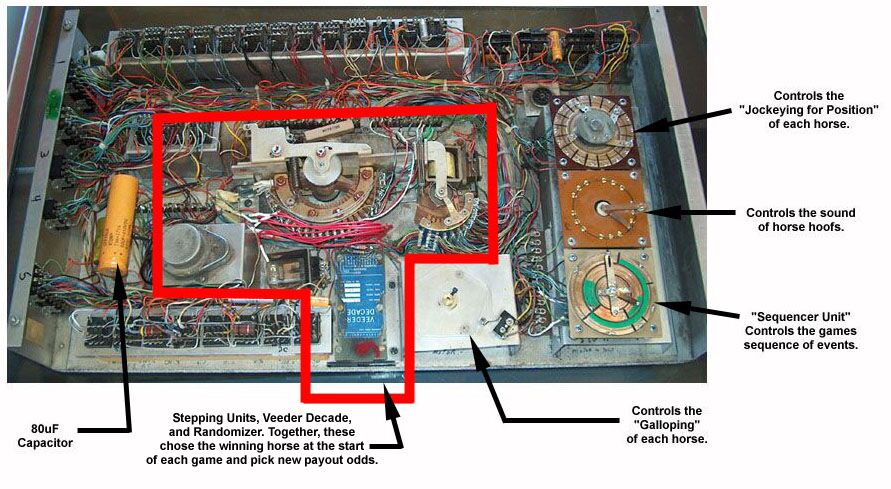 Here is the electro-machanical computer and controller that sits in the lower cabinet.
Here is the electro-machanical computer and controller that sits in the lower cabinet.
Note on playing AVI files: If you have a firewall on your computer, like ZoneAlarm, you may need to disable it or check its settings if this video does not play. If your firewall is blocking this download, it will let Windows Media Player open when you click on the video link above, but then it will give you an error message that says "it cannot find the file" or "the file does not exist." Please be patient, the video may take a minute or two to download before it begins to play.
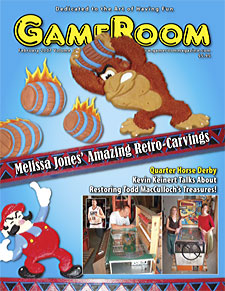 I wrote an article on the restoration of the Quarter Horse Derby and the Kasco Untouchable. The article was printed in the Feburary and March 2007 issues of Gameroom Magazine.
I wrote an article on the restoration of the Quarter Horse Derby and the Kasco Untouchable. The article was printed in the Feburary and March 2007 issues of Gameroom Magazine.
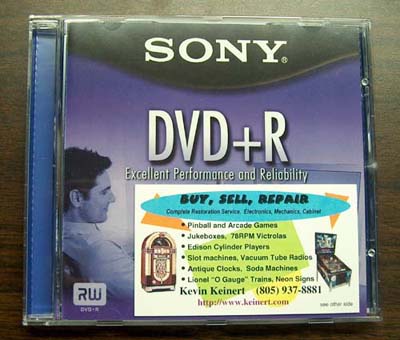 In addition, I video taped the restoration of the Quarter Horse Derby game and created a one hour long DVD. This video is a step-by-step tour through
the mechanical and electrical circuits inside this unique machine. It describes the game's operation from start to finish. It also shows many of the
problems that this game had, and how I repaired them. Included on the DVD, is video of the horses racing around the track while I narrate the action
and explain the sequence of events that the game progresses through. This video is available on standard-definition (low-res) DVD+R format for $64.95 plus shipping.
In addition, I video taped the restoration of the Quarter Horse Derby game and created a one hour long DVD. This video is a step-by-step tour through
the mechanical and electrical circuits inside this unique machine. It describes the game's operation from start to finish. It also shows many of the
problems that this game had, and how I repaired them. Included on the DVD, is video of the horses racing around the track while I narrate the action
and explain the sequence of events that the game progresses through. This video is available on standard-definition (low-res) DVD+R format for $64.95 plus shipping.
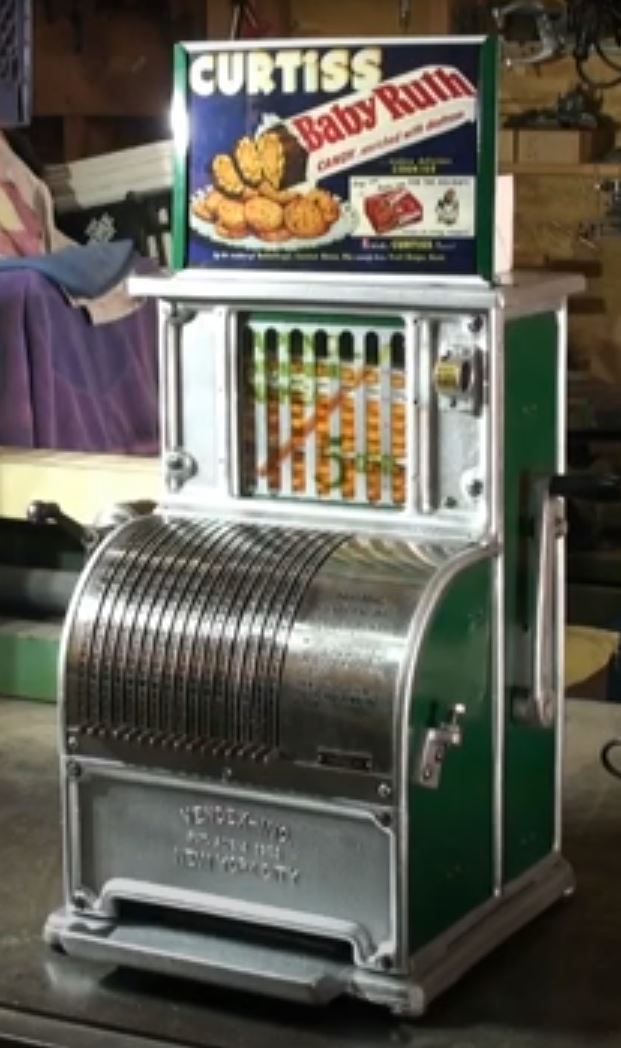
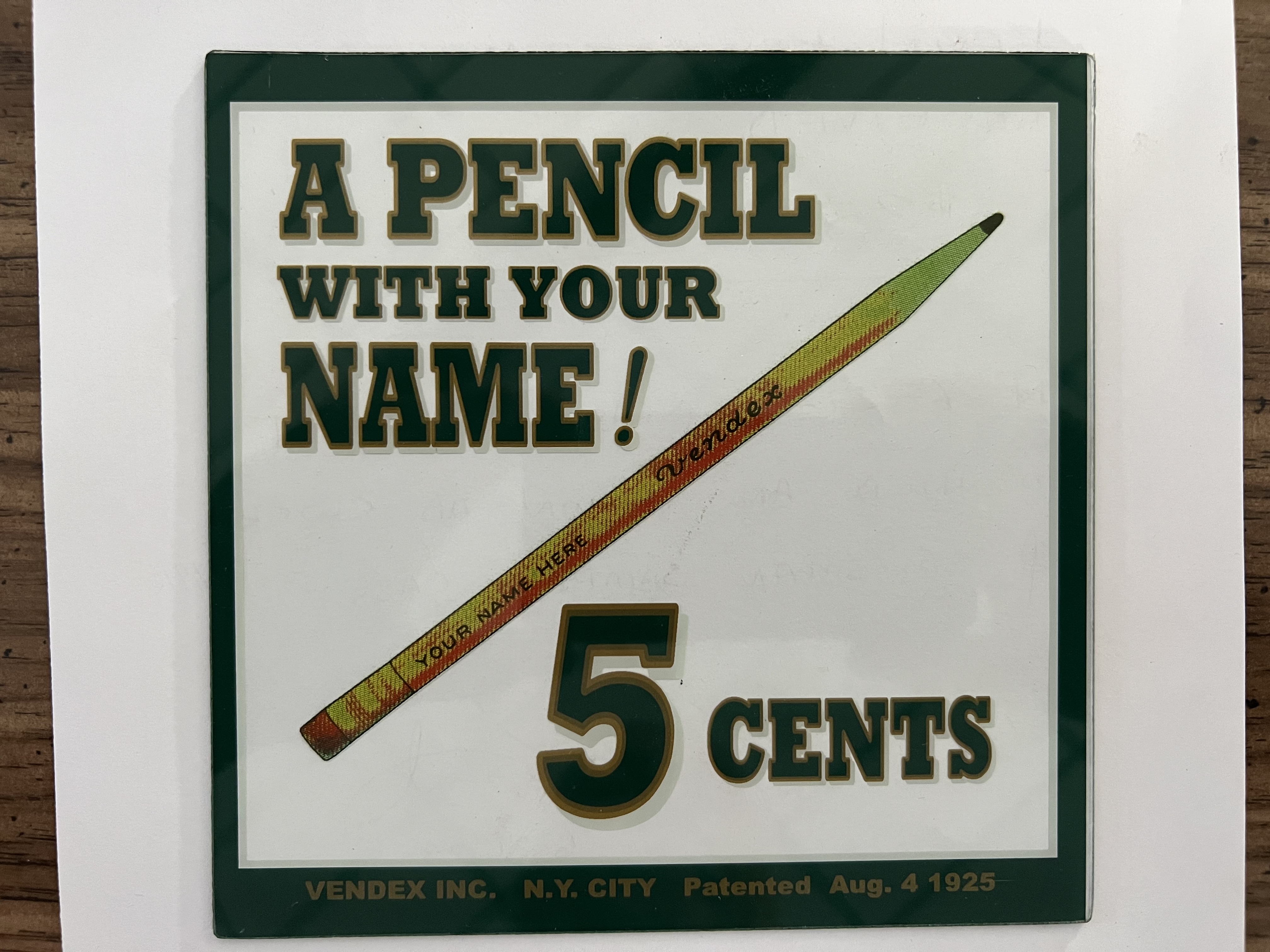
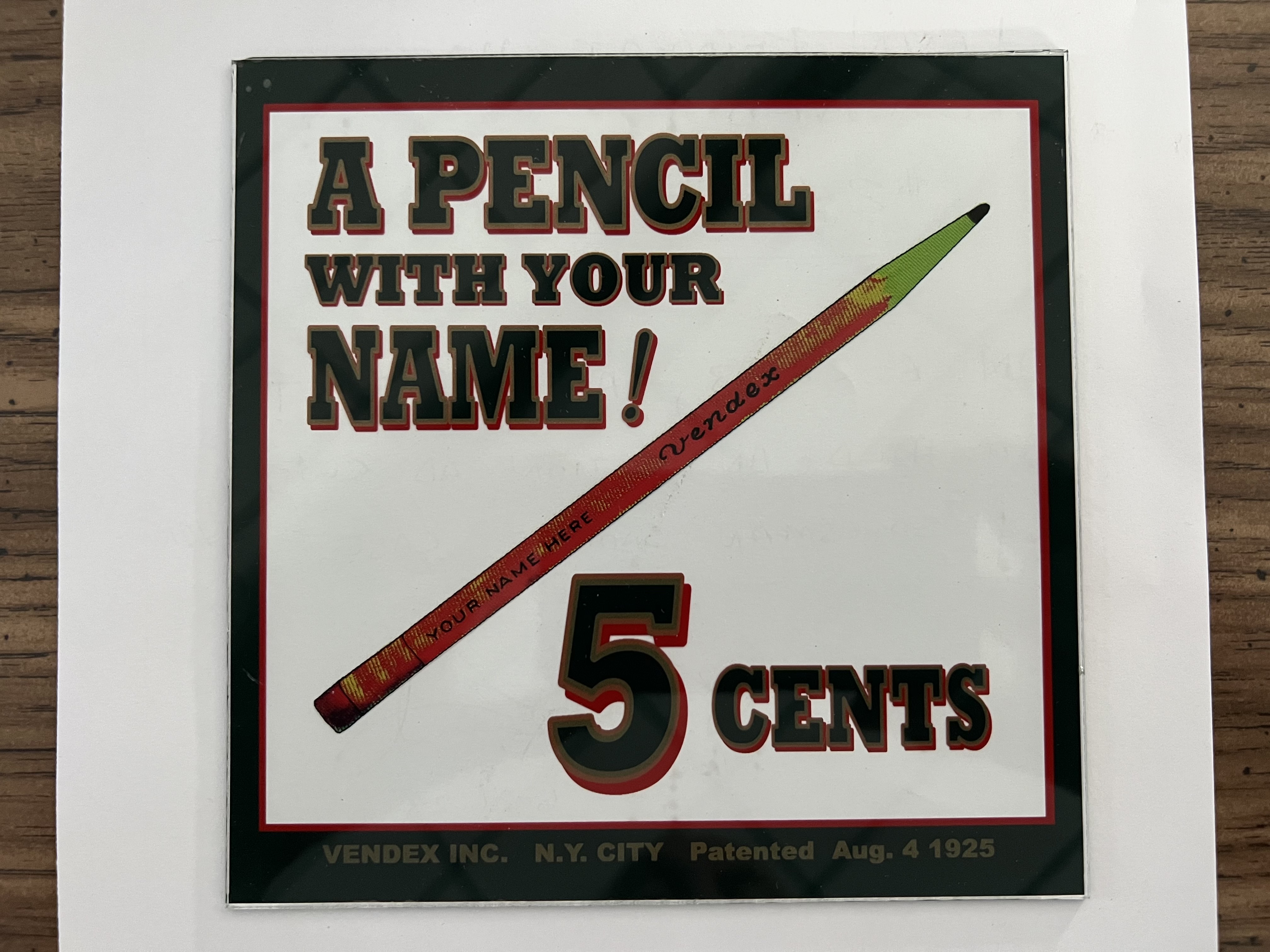 This is a 1925 Pencil Vending Machine by Vendex that stamps 16 letters of your choice onto the pencil before it vends to you. I have reproduced the decal that goes in the pencil viewing window. My decals are currently available in the following formats:
This is a 1925 Pencil Vending Machine by Vendex that stamps 16 letters of your choice onto the pencil before it vends to you. I have reproduced the decal that goes in the pencil viewing window. My decals are currently available in the following formats:
1) White drop-shaddow on lettering, decal only = $95.00 or decal installed on glass and ready to use = $145.00
2) Red drop-shaddow on lettering, decal installed on glass and ready to use = $145.00
CLICK HERE to watch my video of my decal and how to re-ink the pad.
CLICK HERE to watch my video of the full restoration.
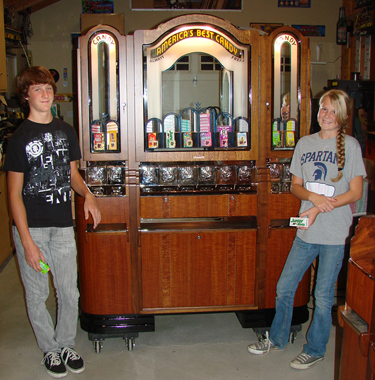 This is a 1920s era Theater Candy Vending Machine called "America's Best Candy."
This is a 1920s era Theater Candy Vending Machine called "America's Best Candy."
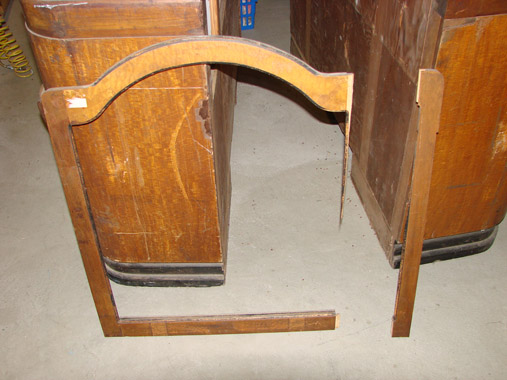
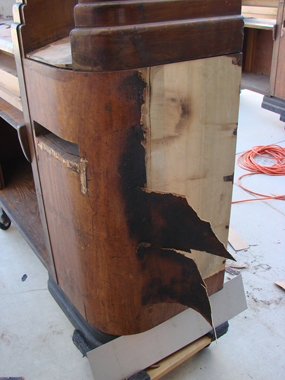
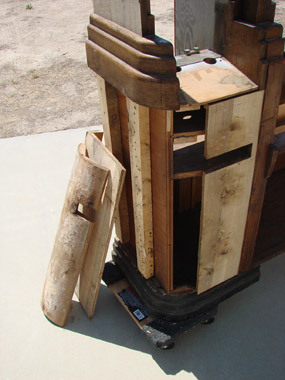 These three pictures show the cabinet during restoration. Every broken piece was carefully re-glued or reattached with screws
before sanding and refinishing. The entire cabinet was stripped and refinished to match the original pattern.
Even though this candy machine is almost 100 years old, I could still buy the exact same veneers and in-lay strips.
The video above includes every detail of the restoration process including how to rebuild and adjust the "Advance" brand coin mechanisms.
These three pictures show the cabinet during restoration. Every broken piece was carefully re-glued or reattached with screws
before sanding and refinishing. The entire cabinet was stripped and refinished to match the original pattern.
Even though this candy machine is almost 100 years old, I could still buy the exact same veneers and in-lay strips.
The video above includes every detail of the restoration process including how to rebuild and adjust the "Advance" brand coin mechanisms.
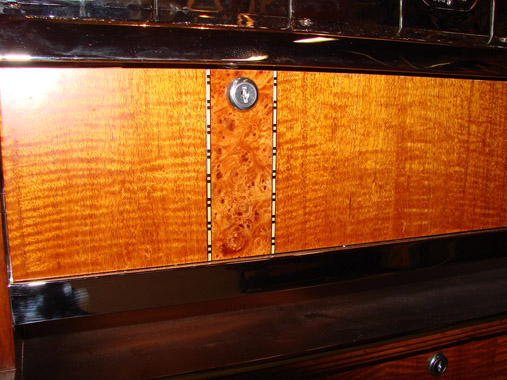
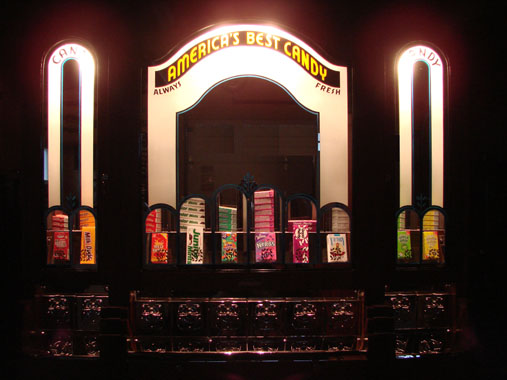 A close up of the new finish. The majority of veneer on the cabinet is Figured Mahogany. The veneer in-between the marquetry inlay strips is Maple Burl.
A close up of the new finish. The majority of veneer on the cabinet is Figured Mahogany. The veneer in-between the marquetry inlay strips is Maple Burl.
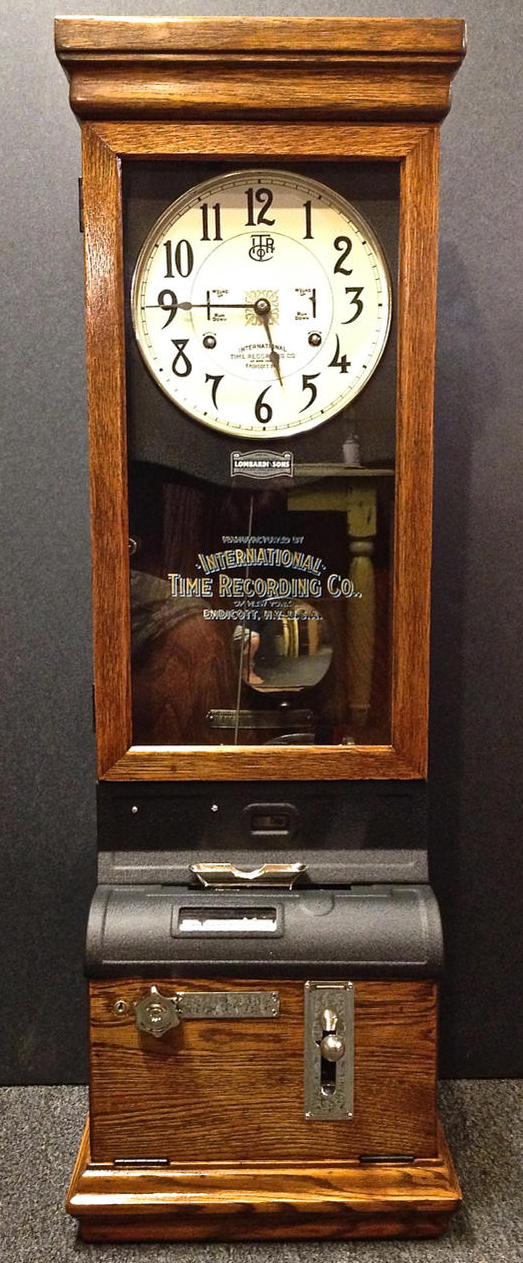
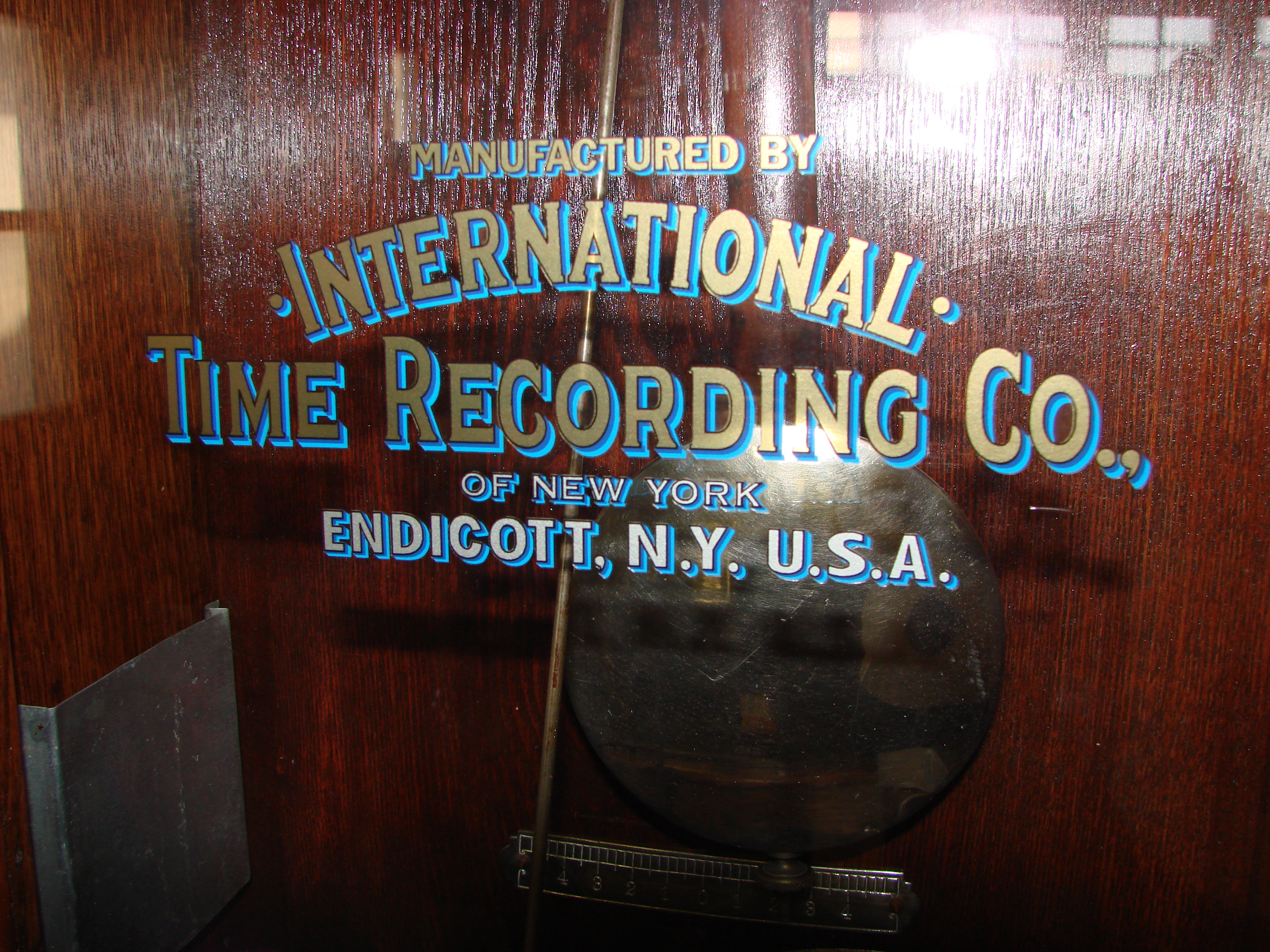
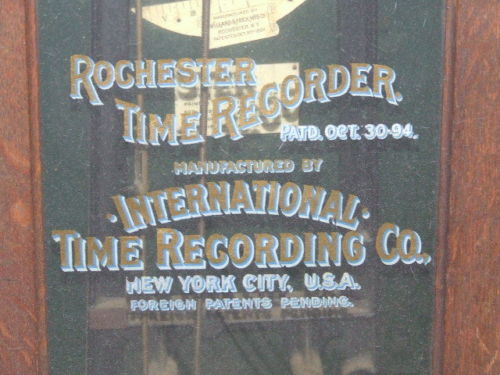 Here's a few pictures of the International Time Recording Co. decal and the Rochester Time Recorder decals I sell. They are "Dry Transfer" rub-on decals that are very easy to apply. The decal is applied to the back side of the glass and has a self-curing adhesive which makes the letters permanent and very durable. Manufacturing costs of these decals can varry, so please contact me for latest pricing. I also sell the bi-color black and red ink ribbon for these time clocks.
Here's a few pictures of the International Time Recording Co. decal and the Rochester Time Recorder decals I sell. They are "Dry Transfer" rub-on decals that are very easy to apply. The decal is applied to the back side of the glass and has a self-curing adhesive which makes the letters permanent and very durable. Manufacturing costs of these decals can varry, so please contact me for latest pricing. I also sell the bi-color black and red ink ribbon for these time clocks.
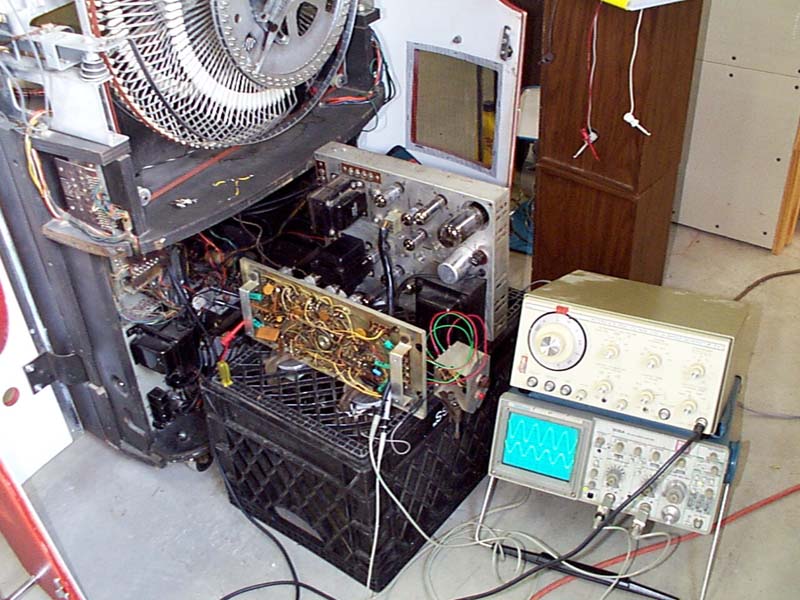 Jukebox enthusiasts will recognize this as the arse end of an AMI Continental II "Stereo Round" jukebox. In this picture, I had just finished a complete
rebuild of the tube amplifier and I am checking its frequency response with a signal generator and O-scope. The Stereo Round is a unique design because
the speakers for the left and right channels are mounted opposing each other, on the left and right sides of the cabinet (so they face away from each other).
In order to re-create the true stereo sound of the 45RPM records being played, it is necessary to place this jukebox firmly into the corner of a room at a 45
degree angle to the walls. This causes the sound waves that emanate from the cabinet sides to bounce off the walls and travel into the center of the room
in parallel which each other and thereby create stereo sound. In addition, these stereo speakers are out of phase with the large woofer that is located
in the front base of the cabinet. This phase mismatch is necessary so that the lag created by bouncing sound waves off of the walls will be compensated
for, and corrected, in the final (cumulative) sound waves that reach your ears. It's a rather bizarre approach to stereo acoustics.
Jukebox enthusiasts will recognize this as the arse end of an AMI Continental II "Stereo Round" jukebox. In this picture, I had just finished a complete
rebuild of the tube amplifier and I am checking its frequency response with a signal generator and O-scope. The Stereo Round is a unique design because
the speakers for the left and right channels are mounted opposing each other, on the left and right sides of the cabinet (so they face away from each other).
In order to re-create the true stereo sound of the 45RPM records being played, it is necessary to place this jukebox firmly into the corner of a room at a 45
degree angle to the walls. This causes the sound waves that emanate from the cabinet sides to bounce off the walls and travel into the center of the room
in parallel which each other and thereby create stereo sound. In addition, these stereo speakers are out of phase with the large woofer that is located
in the front base of the cabinet. This phase mismatch is necessary so that the lag created by bouncing sound waves off of the walls will be compensated
for, and corrected, in the final (cumulative) sound waves that reach your ears. It's a rather bizarre approach to stereo acoustics.
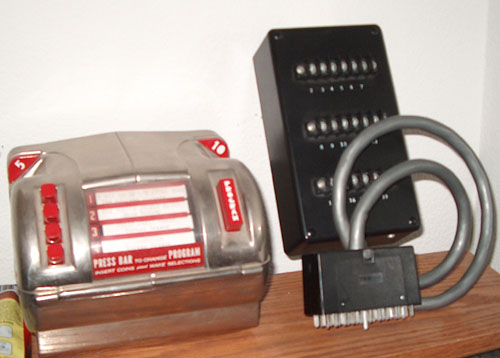
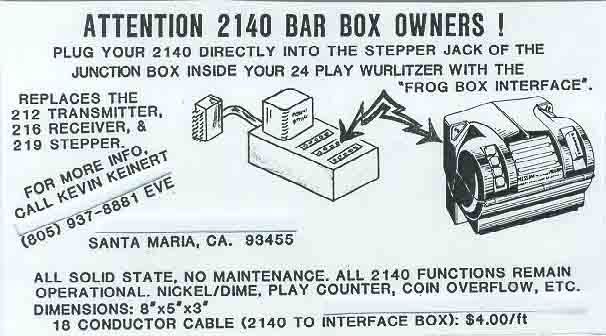 My interface box is used to connect a Wurlitzer 2140 barbox (or Frog Box), to a Wurlitzer 24 play jukebox.
24 play mechanisms are found in models like the Wurlitzer 1015, 1100, 1080 and others.
The three units that were originally needed to connect a Frog Box, were the model 212 wireless transmitter,
the 216 wireless receiver, and the 219 stepper. My interface unit is a "wired system" that replaces all three.
A cable must be run from the frogbox to my interface unit. The interface sits inside the jukebox (where the 219 stepper would normally go)
and plugs into the 33 pin "Jones Connector" on the junction box (inside the jukebox).
The logic circuitry inside my interface unit replicates all of the original 2140 frogbox functions, which includes
1) Coin overflow lockout (barbox shuts off, if a coin gets stuck inside).
2) Play meter increment pulse (pulses the playmeter on the junction box, inside the jukebox).
3) Gives you one play for a nickel or two plays for a dime.
My interface box is used to connect a Wurlitzer 2140 barbox (or Frog Box), to a Wurlitzer 24 play jukebox.
24 play mechanisms are found in models like the Wurlitzer 1015, 1100, 1080 and others.
The three units that were originally needed to connect a Frog Box, were the model 212 wireless transmitter,
the 216 wireless receiver, and the 219 stepper. My interface unit is a "wired system" that replaces all three.
A cable must be run from the frogbox to my interface unit. The interface sits inside the jukebox (where the 219 stepper would normally go)
and plugs into the 33 pin "Jones Connector" on the junction box (inside the jukebox).
The logic circuitry inside my interface unit replicates all of the original 2140 frogbox functions, which includes
1) Coin overflow lockout (barbox shuts off, if a coin gets stuck inside).
2) Play meter increment pulse (pulses the playmeter on the junction box, inside the jukebox).
3) Gives you one play for a nickel or two plays for a dime.
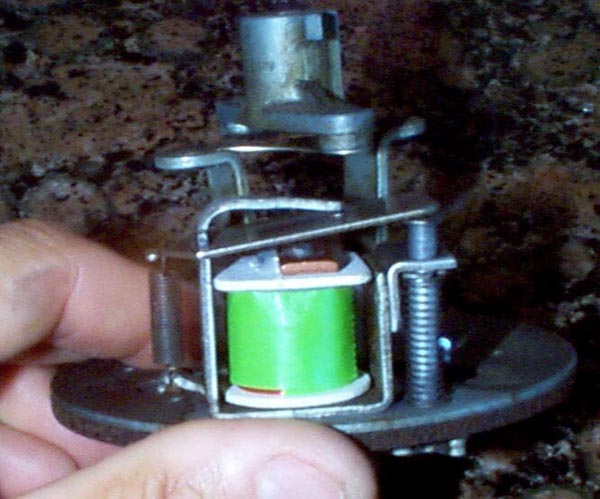 This is the "Selection Cancel Assembly" from a Seeburg M146 thru M148 series (A.K.A. "The Trashcan") jukebox. A customer brought his Trashcan to me
for repair. It was not canceling selections once they were played (IE: the same record would play over and over without advancing to the next selection).
Diagnosis found that the Cancel Relay Coil has burned out. This was a real problem since replacement coils (at the time) were not available through jukebox parts suppliers.
Through research, I found a suitable coil that is a "form, fit and function" replacement for the original. My replacement coil is the green cylindrical piece
shown in this picture. These coils are now available directly from me or by following this link to
The Victory Glass Company.
This is the "Selection Cancel Assembly" from a Seeburg M146 thru M148 series (A.K.A. "The Trashcan") jukebox. A customer brought his Trashcan to me
for repair. It was not canceling selections once they were played (IE: the same record would play over and over without advancing to the next selection).
Diagnosis found that the Cancel Relay Coil has burned out. This was a real problem since replacement coils (at the time) were not available through jukebox parts suppliers.
Through research, I found a suitable coil that is a "form, fit and function" replacement for the original. My replacement coil is the green cylindrical piece
shown in this picture. These coils are now available directly from me or by following this link to
The Victory Glass Company.
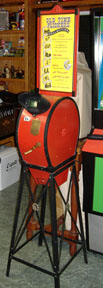 I repair Mutoscope moving picture machines from the late 1800s and early 1900s.
I repair Mutoscope moving picture machines from the late 1800s and early 1900s. 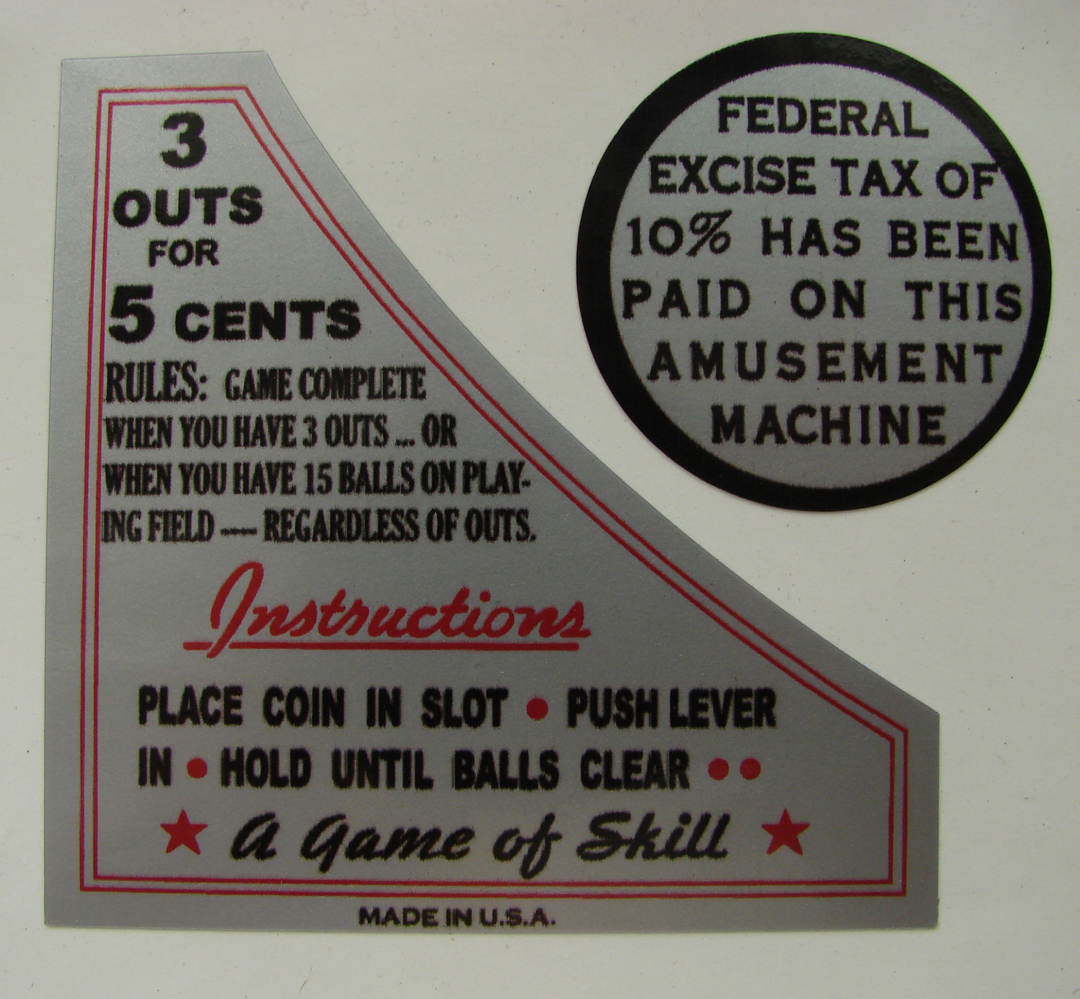
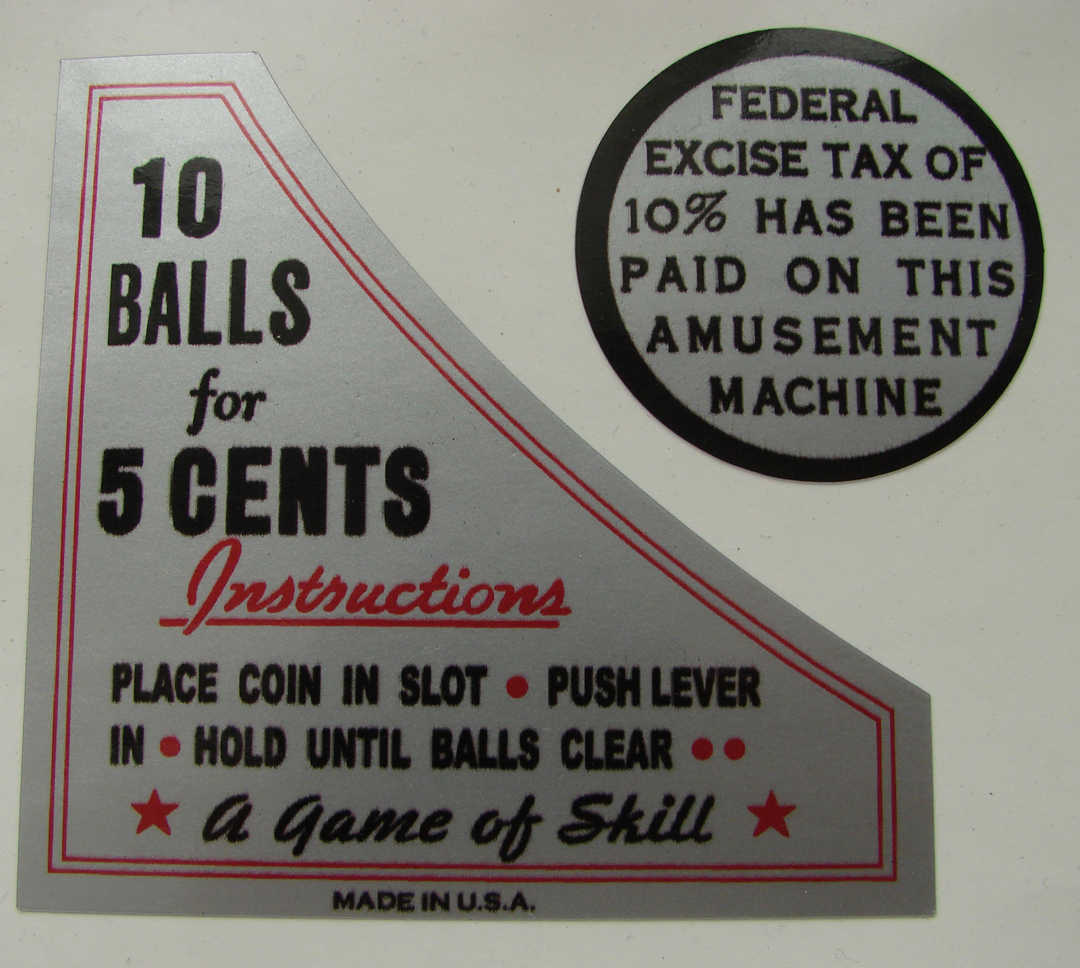
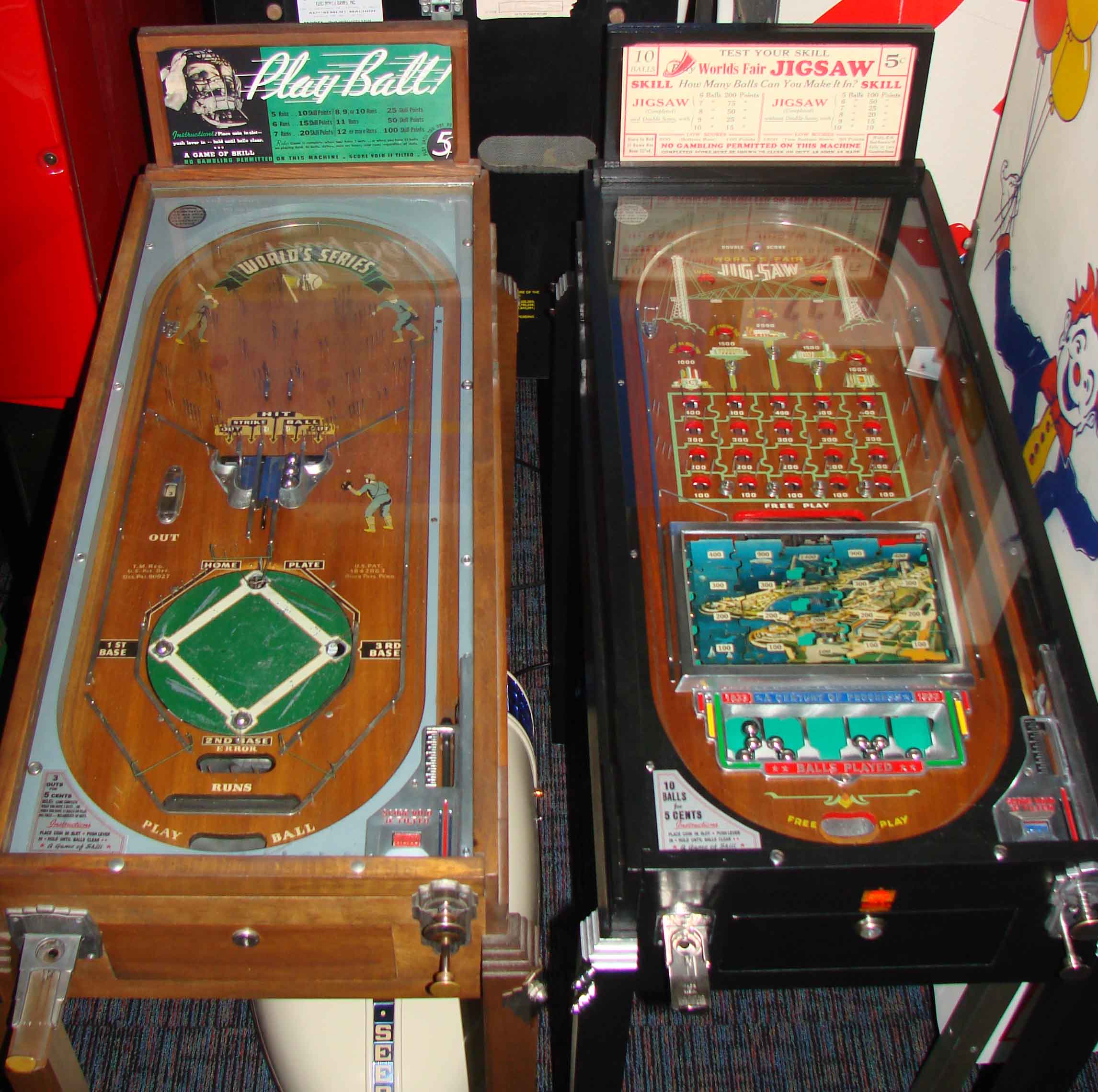 I have reproduced the instruction labels and tax stamps for the Rock-ola World Series and World's Fair Jig-Saw pinball games. Each decal set includes one instruction sticker
and one federal tax sticker for either a World Series or JigSaw as shown in the first two pictures. These decals belong on the games in the right-most picture.
My decals are printed on self-adhesive silver vinyl and then laminated with a semi-gloss clear film so they are very durable compared to the original paper labels. They are die-cut and ready to
peal and stick on your games. They can be cleaned using a mild household cleaner without damaging the printing. They are a very close match to the original
silver foil-covered paper used in the 1930s. Each set of decals (Instructions and Federal Excise Tax) is $42.95 plus shipping and insurance.
I have reproduced the instruction labels and tax stamps for the Rock-ola World Series and World's Fair Jig-Saw pinball games. Each decal set includes one instruction sticker
and one federal tax sticker for either a World Series or JigSaw as shown in the first two pictures. These decals belong on the games in the right-most picture.
My decals are printed on self-adhesive silver vinyl and then laminated with a semi-gloss clear film so they are very durable compared to the original paper labels. They are die-cut and ready to
peal and stick on your games. They can be cleaned using a mild household cleaner without damaging the printing. They are a very close match to the original
silver foil-covered paper used in the 1930s. Each set of decals (Instructions and Federal Excise Tax) is $42.95 plus shipping and insurance.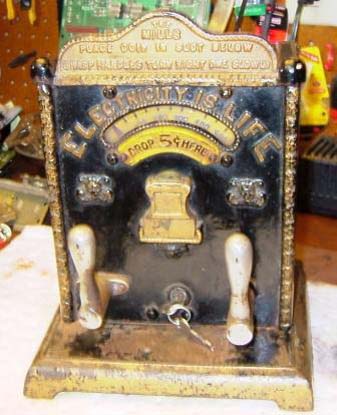
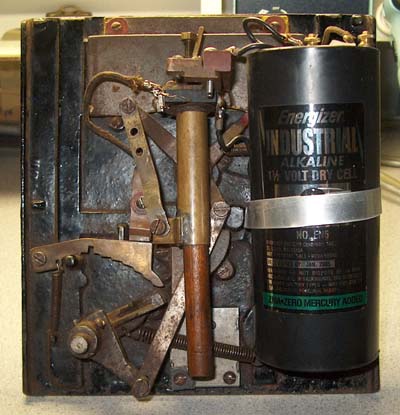 This is a penny arcade shocking machine from around 1904. "Electricity Is Life", made by the Mills Novelty Co. You drop in a nickel, grab both handles
and slowly turn the handle on the right. As you rotate the handle, an electric shock is delivered to the handles. The voltage starts out low, but increases
as you crank the handle. I can only turn it about half way before I have to let go (ouch). I repaired this machine for a customer in Jan. 2007. It's powered
by a single 1.5V #6 dry cell battery. The mechanism is very ingenious. The coin (a nickel) actually closes the electrical circuit and allows current to flow.
The battery voltage is stepped up to a shocking potential (pun intended) by a "step-up transformer," of which the secondary winding is connected to the handles.
The transformer is the skinny rod, which is vertically mounted in the center of the machine, as seen in this picture. There is a brass sleeve that covers
the transformer shaft. As you rotate the handle, this sleeve will slide down the shaft and cause the following to occur: At the start of the game when the
handle is up-right, the brass sleeve is covering the transformer windings and shunting the magnetic field. Therefore, the output voltage is low. But as the
handle is rotated, the sleeve will move down the shaft and uncover the transformer, which allows the magnetic field to grow, which in turn delivers more
"life giving electrical stimulus" (IE: a good old fashion zap) to the person willing to deposit his nickel and hold on....
CLICK HERE to watch a video on these Shocker Machines.
This is a penny arcade shocking machine from around 1904. "Electricity Is Life", made by the Mills Novelty Co. You drop in a nickel, grab both handles
and slowly turn the handle on the right. As you rotate the handle, an electric shock is delivered to the handles. The voltage starts out low, but increases
as you crank the handle. I can only turn it about half way before I have to let go (ouch). I repaired this machine for a customer in Jan. 2007. It's powered
by a single 1.5V #6 dry cell battery. The mechanism is very ingenious. The coin (a nickel) actually closes the electrical circuit and allows current to flow.
The battery voltage is stepped up to a shocking potential (pun intended) by a "step-up transformer," of which the secondary winding is connected to the handles.
The transformer is the skinny rod, which is vertically mounted in the center of the machine, as seen in this picture. There is a brass sleeve that covers
the transformer shaft. As you rotate the handle, this sleeve will slide down the shaft and cause the following to occur: At the start of the game when the
handle is up-right, the brass sleeve is covering the transformer windings and shunting the magnetic field. Therefore, the output voltage is low. But as the
handle is rotated, the sleeve will move down the shaft and uncover the transformer, which allows the magnetic field to grow, which in turn delivers more
"life giving electrical stimulus" (IE: a good old fashion zap) to the person willing to deposit his nickel and hold on....
CLICK HERE to watch a video on these Shocker Machines. 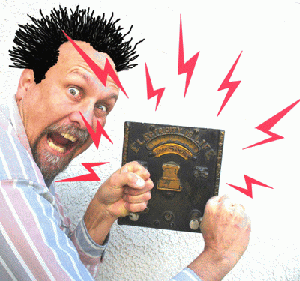 All of my repairs include sophisticated and rigorous testing to insure proper operation.
All of my repairs include sophisticated and rigorous testing to insure proper operation.
Please contact me if you have any questions,
or visit my main webpage at http://www.GameRoomRepair.com for more information.
Thanks for your visit.

Kevin R. Keinert
4351 Beverly Dr.
Santa Maria, California
93455 USA
(805) 937-8881